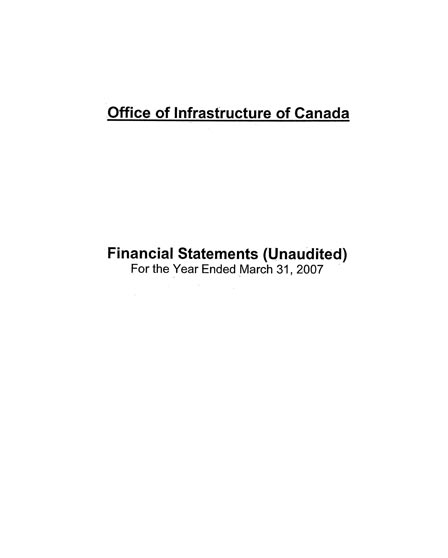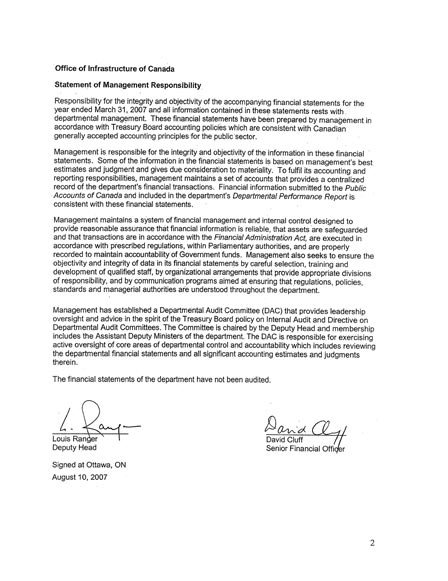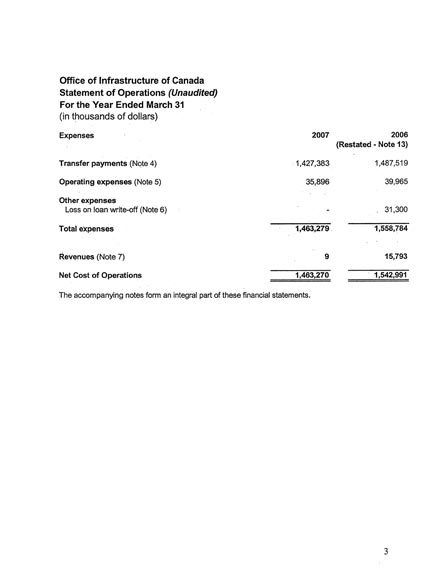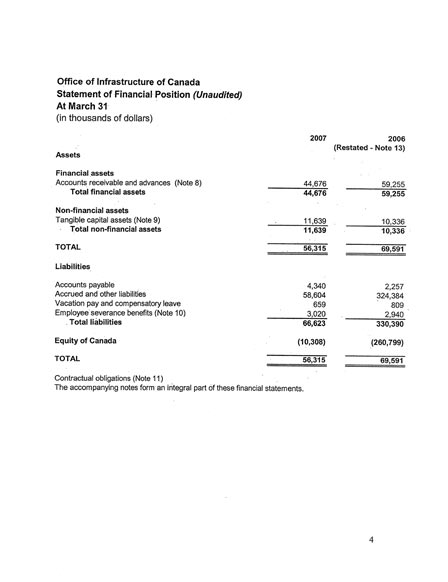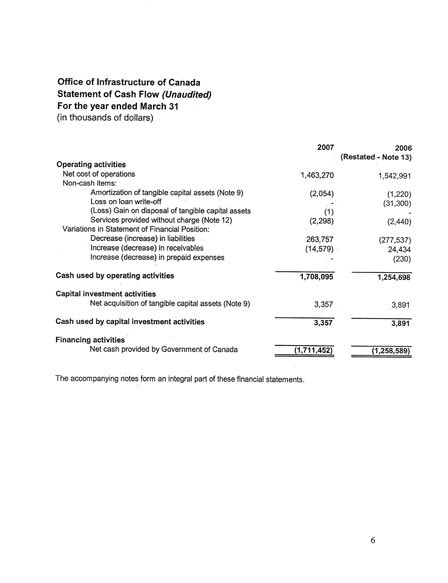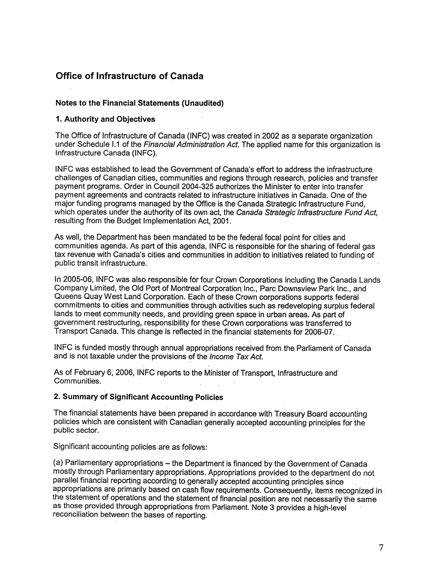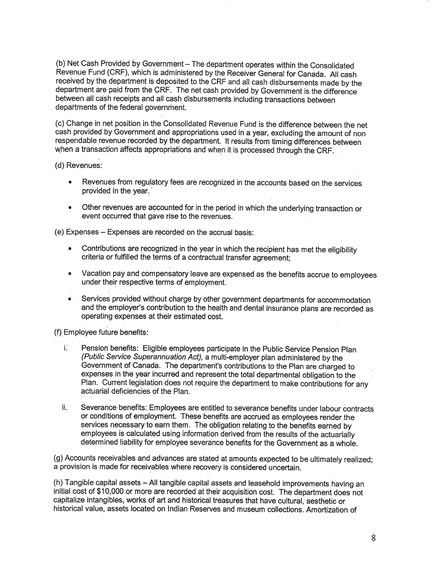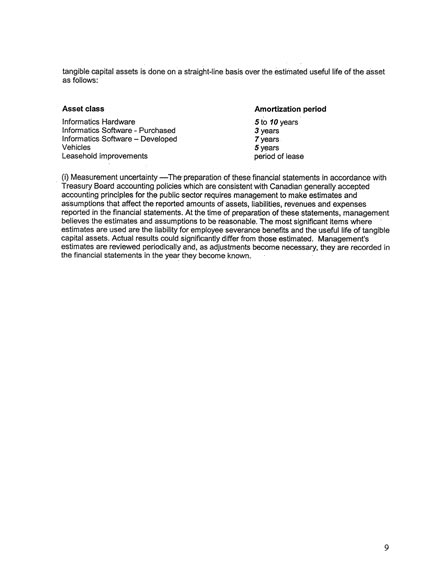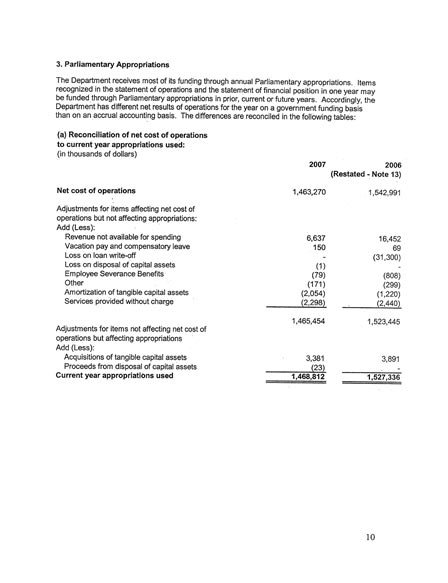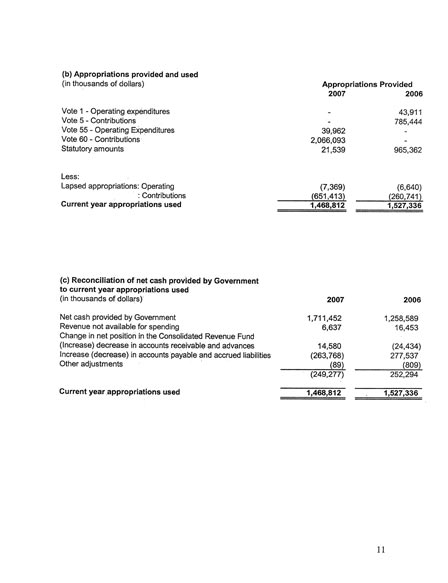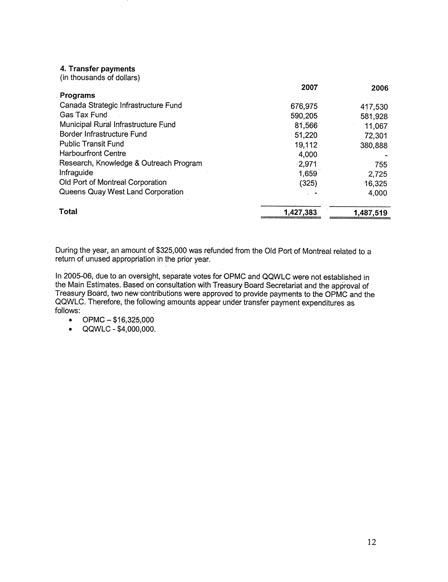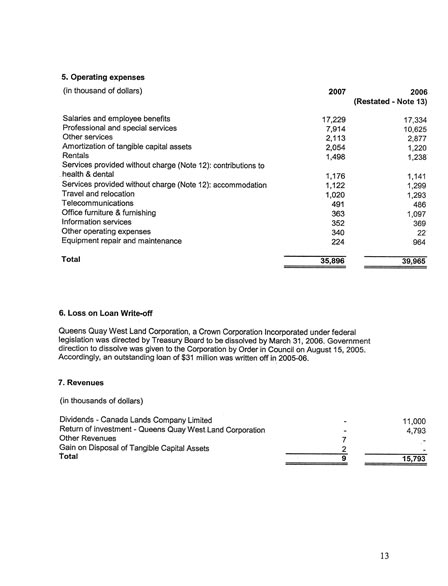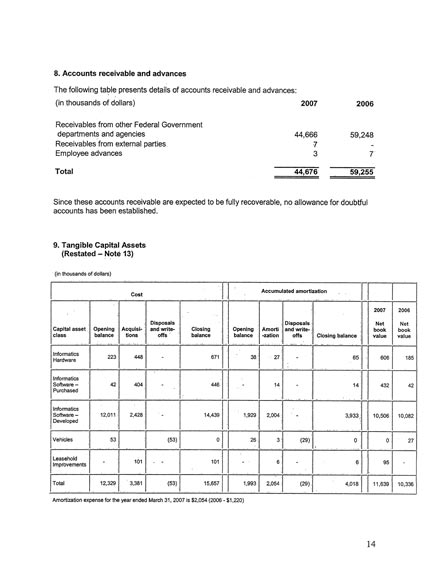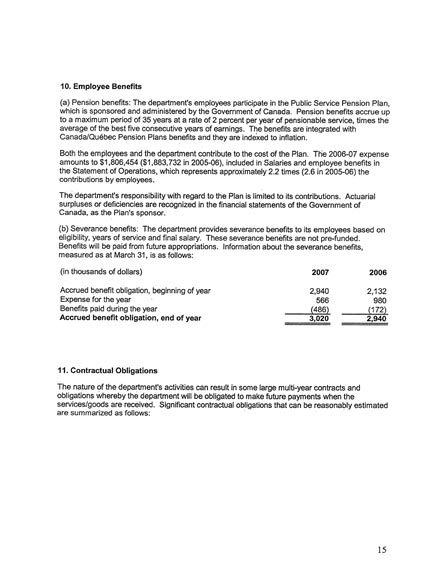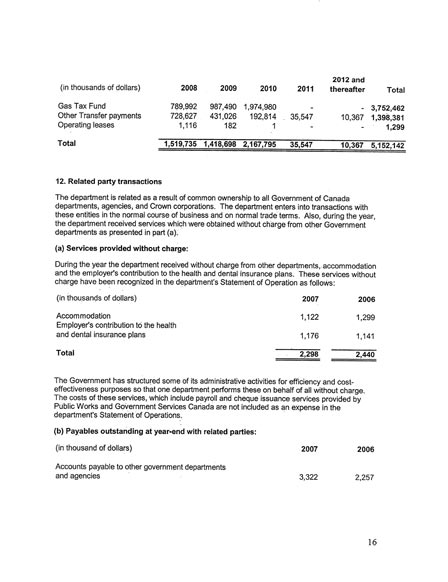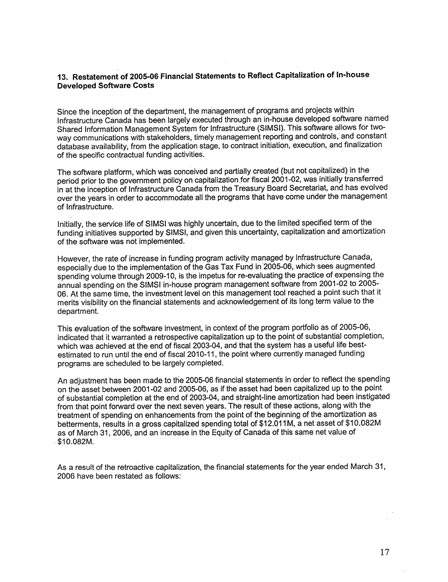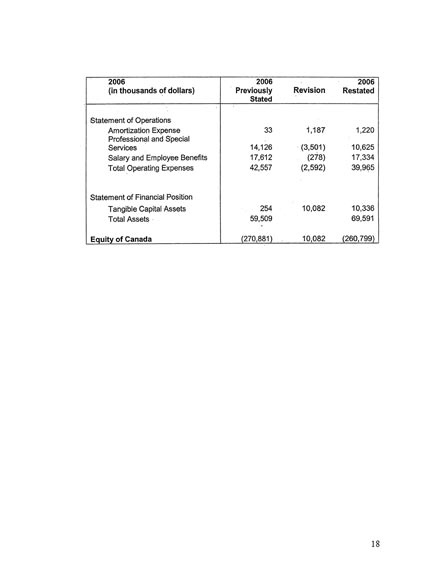ARCHIVED - Infrastructure Canada
 This page has been archived.
This page has been archived.
Archived Content
Information identified as archived on the Web is for reference, research or recordkeeping purposes. It has not been altered or updated after the date of archiving. Web pages that are archived on the Web are not subject to the Government of Canada Web Standards. As per the Communications Policy of the Government of Canada, you can request alternate formats on the "Contact Us" page.
2006-2007
Departmental Performance Report
Infrastructure Canada
The Honourable Lawrence Cannon
Minister of Transport, Infrastructure and Communities
Table of Contents
- Minister’s Message
- Management Representation Statement
- 1.1 Summary Information
- 1.2 Program Activity Architecture (PAA) Crosswalk
- 1.3 Summary of Departmental Performance
Section II: Analysis of Program Activities By Strategic Outcome
- 2.1 Program Activity 1: Infrastructure Investments
- 2.2 Program Activity 2: Policy, Knowledge and Partnership Development
Section III: Supplementary Information
Section IV: Other Items of Interest
- 4.1 Departmental Administration and Management Initiatives
- 4.2 Additional Information on Infrastructure Investment Programs
- 4.3 Contacts
Section I: Overview
Minister’s Message

Lawrence Cannon,
P.C., M.P.
As Canada’s Minister of Transport, Infrastructure and Communities, I am pleased to submit Infrastructure Canada’s Departmental Performance Report for the period ended March 31, 2007.
The Transport, Infrastructure and Communities Portfolio, including Infrastructure Canada, contributes to our economic growth and environmental sustainability and helps to ensure the safety and security of our transportation infrastructure.
This was a busy and dynamic year that saw the Government of Canada deliver two budgets that committed a historic $33 billion over the next seven years towards the new Building Canada infrastructure plan. This long-term, unprecedented level of infrastructure funding recognizes that to remain competitive in today’s economy, we must create world-class infrastructure to ensure the seamless flow of people, goods and services across our roads and bridges and through our ports and gateways. The Building Canada plan will also support the environment through investments in public transit, green energy, water and wastewater treatment and brownfield remediation.
The Building Canada plan reflects input we received during the summer of 2006 from provinces, territories, the municipal sector and stakeholders. It addresses issues that matter to Canadians, such as safe roads and bridges, a clean environment and a strong economy. These areas are important to Canadians from coast to coast and that is where we intend to focus our efforts.
In fact, we have already started to take action. For example, the Government of Canada committed $26.7 million to help clean up Saint John Harbour in New Brunswick and $150 million to the twinning of Highway 63 in Alberta. We have also finalized our commitment of $332.5 million to complete the Manitoba Red River Floodway Expansion project.
In addition, communities are investing Gas Tax funding to improve their infrastructure and the environment and all provinces and territories have received their share of the $1.3 billion committed to transit through the Public Transit Fund and the Public Transit Capital Trust. As well, the Government of Canada announced close to $1 billion to improve transit in the Greater Toronto Area.
As we look to the future and the challenges that lie ahead, Infrastructure Canada is committed to sustaining its efforts as part of the Transport, Infrastructure and Communities Portfolio and building a modern Canada – stronger, safer, better.
The Honourable Lawrence Cannon, P.C., M.P.
Minister of Transport, Infrastructure and Communities
Lawrence Cannon,
P.C., M.P.
Management Representation Statement
I submit for tabling in Parliament, the 2006-2007 Departmental Performance Report for Infrastructure Canada.
This document has been prepared based on the reporting principles contained in the Guide for the Preparation of Part III of the 2006-2007 Estimates: Reports on Plans and Priorities and Departmental Performance Reports:
- It adheres to the specific reporting requirements outlined in the Treasury Board Secretariat guidance;
- It is based on the Department’s approved Strategic Outcome(s) and Program Activity Architecture that were approved by the Treasury Board;
- It presents consistent, comprehensive, balanced and reliable information;
- It provides a basis of accountability for the results achieved with the resources and authorities entrusted to it; and
- It reports finances based on approved numbers from the Estimates and the Public Accounts of Canada.
The paper version was signed by
Louis Ranger
Deputy Head
Infrastructure and Communities
1.1 Summary Information
Infrastructure Canada’s mission is to build world class public infrastructure that contributes to Canada’s economic growth, a clean environment and strong communities for Canadians. This Departmental Performance Report (DPR) presents information on the activities and achievement of Infrastructure Canada in fiscal year 2006-2007 against the expected results described in the Report on Plans and Priorities for 2006-2007. During this year, the federal government made significant additional commitments to build and modernize Canada’s infrastructure – with a focus on supporting Canada’s economy, environment and quality of life.
Department’s Reason for Existence — Infrastructure Canada seeks to help build sustainable cities and communities where Canadians benefit from world-class public infrastructure1.
Canada needs to remain competitive and productive while sustaining the quality of life of Canadians. The Government of Canada realizes that world-class public infrastructure, such as an efficient transportation network and safe and reliable water systems, is key to meeting these objectives. Budget 2007, tabled in March, recognizes that modern, accessible infrastructure matters to Canadians. It helps move people and goods to markets, allowing our economy to grow and prosper. Through public transit and water treatment systems, infrastructure investments will mean a cleaner, greener Canada. Investing in infrastructure:
- Helps ensure goods get to market quickly and seamlessly;
- Reduces the time people spend in traffic, getting to work and home to their families more quickly;
- Provides Canadians with clean water; and
- Results in stronger communities.
The Government is committed to working in partnership with provinces, territories, municipalities and private and non-profit sectors to build a stronger Canada for the benefit of all Canadians. Infrastructure Canada was established in 2002 to lead the Government of Canada’s effort to address the infrastructure challenges of Canadian cities, communities and regions.
In carrying out this Government priority, Infrastructure Canada delivers or coordinates several funding programs and works to build the policies, knowledge and partnerships necessary to support them.
In February 2006, Infrastructure Canada and Transport Canada became part of a new portfolio, Transport, Infrastructure and Communities (TIC), which includes sixteen Crown corporations. In August 2006, the management of Infrastructure Canada and Transport Canada became the responsibility of a single deputy minister. The TIC portfolio addresses several of the challenges facing Canada, particularly the modernization of public infrastructure and the sustainability of both the environment and economic growth. Transport Canada and the other portfolio organizations, each report on their annual plans and performance separately.
Table 1.1: Financial Resources (in $ thousands), 2006-2007
|
Planned Spending |
Total Authorities |
Actual Spending |
|---|---|---|
|
2,468,311 |
2,127,643 |
1,471,134 |
The variance between total authorities and actual spending is explained in the narrative for Table 3.1 of Section III.
Table 1.2: Human Resources (Full-time Equivalents), 2006-2007
|
Planned |
Actual |
Difference |
|---|---|---|
|
220 |
184 |
36 |
1.2 Program Activity Architecture (PAA) Crosswalk
Building on the experience gained in implementing infrastructure programs and given the scope of changes to its responsibilities, Infrastructure Canada sought and received approval from the Treasury Board in the spring of 2006 to amend its Program Activity Architecture (PAA).
|
Previous Strategic Outcome: |
Revised Strategic Outcome: |
|---|---|
|
To meet the priorities of Canadians for infrastructure in order to contribute to quality of life, healthy environment, economic growth, rural and urban development, innovation and international trade. |
Improving the sustainability of our cities and communities and Canada’s local, regional and national public infrastructure to enhance the economic, social, cultural and environmental quality of life of Canadians. |
The amended Strategic Outcome was more directly linked to the Government’s priorities during 2006-2007 and better reflected the broader mandate of the organization including its role with respect to contributing to the sustainability of cities and communities. The revised PAA better reflects how Infrastructure Canada allocated and managed the resources under its control to achieve its expected results.
Table 1.3 compares the revised PAA with the previous one, in terms of Program Activities and funding levels. The changes in Program Activities reflect the experience gained in implementing infrastructure programs, recent reorganizations of functions and developing departmental management accountability and reporting structures. The reorganization reflected in the revised Strategic Outcome and PAA includes the transfer out of the Crown Corporations Portfolio.2
Under the revised PAA, Infrastructure Canada has three Program Activities: Infrastructure Investments; Policy, Knowledge and Partnership Development; and Departmental Administration. The three Program Activities are briefly described below:
- Infrastructure Investments: This Program Activity consists of all infrastructure programming delivered through transfer payments, as well as the related program management and monitoring functions. The Activity contributes to the construction, renewal and enhancement of public infrastructure in Canada and, in partnership with others, builds capacity
for addressing infrastructure and communities issues. More detailed information about this Activity is provided in Section II.
- Policy, Knowledge and Partnership Development: This Program Activity consists of activities undertaken in policy, knowledge, research and analysis and partnership development. The Activity develops policies based on research and strong partnerships to address existing and emerging challenges and opportunities. More detailed information about this
Activity is provided in Section II.
- Departmental Administration: This Program Activity encompasses the Office of the Deputy Head, Corporate Services, Communications and Legal Services. The Activity promotes excellence in program and corporate management in support of Infrastructure Canada’s priorities. Section IV provides additional information about this Activity.
Table 1.3: Infrastructure Canada: Revised Program Activity Architecture – Main Estimates 2006-2007 ($ thousands)
|
Previous Strategic Outcome |
Revised Strategic Outcome |
Reason for Change |
|---|---|---|
|
To meet the priorities of Canadians for infrastructure in order to contribute to quality of life, healthy environment, economic growth, rural and urban development, innovation and international trade. |
Improving the sustainability of our cities and communities and Canada’s local, regional and national public infrastructure to enhance the economic, social, cultural and environmental quality of life of Canadians. |
The revised Strategic Outcome better reflects Infrastructure Canada’s mandate and vision and is linked to the Government’s priorities. |
|
Previous Program Activity |
Revised Program Activity |
Reason for Change |
| 1. Infrastructure and Communities $1,824,127 |
1. Infrastructure Investments $1,808,681 2. Policy, Knowledge and Partnership Development $15,446 |
Development of better organizational accountability and reporting functions. |
| 2. Crown Corporations Portfolio Management $22,9893 |
|
Responsibility transferred to Transport Canada. |
| 3. Departmental Administration4 | 3. Departmental Administration4 |
Moved Communications activities from the Infrastructure and Communities activity (since they support and apply to all departmental activities) |
The new organization more accurately reflects Infrastructure Canada’s key areas of achievement and sets the stage to strengthen departmental performance reporting. Section III provides additional organizational information.
1 Public infrastructure is defined as the core physical assets instrumental in supporting the delivery of public services.
2 The four Crown corporations (transferred to Transport, Infrastructure and Communities Portfolio in 2005-2006) are the Canada Lands Company Limited, Old Port of Montréal Corporation Inc., Parc Downsview Park Inc. and Queens Quay West Land Corporation.
3 Although the transfer of the Crown Corporations was announced late in fiscal year 2005-2006, the actual transfer of these funds to Transport Canada occurred in 2006-2007.
4 Because the Departmental Administration Activity supports Activities 1 and 2, funding is prorated to those Activities.
1.3 Summary of Departmental Performance
1.3.1 Performance in Relation to Departmental Strategic Outcome, Priorities and Results
Table 1.4 summarizes the performance status on the expected results as they relate to the departmental strategic outcome, priority and program activity.
Table 1.4: Summary of Performance in Relation to Departmental Strategic Outcome, Priorities and Results
|
Status on Performance |
||||
|---|---|---|---|---|
|
Strategic Outcome: Improving the sustainability of our cities and communities and Canada’s local, regional and national public infrastructure to enhance the economic, social, cultural and environmental quality of life of Canadians. |
2006-2007 ($ thousands) |
|||
|
Priority & Type |
Program Activity |
Expected Results & Achievements |
Planned Spending |
Actual |
| 1. Delivering approved program funding (ongoing) |
1. Infrastructure Investments Infrastructure Canada delivers or coordinates a suite of federal public infrastructure funding programs:
|
Successfully met expectations during the reporting period.
|
2,448,418 |
1,455,063 |
| 2. Developing Policy, Knowledge and Partnerships (ongoing) |
2. Policy, Knowledge and Partnership Development
|
Successfully met expectations during the reporting period.
|
17,401 |
13,773 |
1.3.2 Progress by Organizational Priorities
Priority 1: Delivering Approved Program Funding
Through investments in public infrastructure, Infrastructure Canada seeks to maximize economic and environmental benefits for Canadians and to strengthen communities. It does this in partnership with the provinces and territories, municipalities, First Nations and stakeholders. Infrastructure Canada delivers or coordinates a suite of six infrastructure funding programs, each responding to distinct aspects of Canada’s priority infrastructure needs.
The investment of more than $16 billion in infrastructure announced in Budget 2007 brings federal support under a new Building Canada Infrastructure Plan to a total of $33 billion over the next seven years. This includes funding allocated in Budget 2006 of $16.5 billion over four years for public infrastructure across Canada of which $6.6 billion was new funding to support both small- and large-scale municipal infrastructure in communities. In addition, Budget 2006’s Advantage Canada5 confirmed the Government’s gas tax funding commitment for the remaining four years, through 2009-2010. Budget 2007 delivered on commitment made in Advantage Canada by implementing a comprehensive infrastructure plan based on advice received during consultations in the summer 2006 with provinces, territories, the municipal sector and stakeholders. The new Building Canada Infrastructure Plan will make an important contribution towards the efforts of the Government to drive the economy, support the environment and build a safer, stronger and better Canada and will provide greater predictability, flexibility and accountability.
The CSIF, BIF, ICP and MRIF Programs
These four Programs are delivered or coordinated in partnership with other federal departments and agencies. Projects are managed collaboratively under the terms of specific Memoranda of Understanding. As the coordinator and funding agent, Infrastructure Canada is responsible for project review, selection and approval, negotiation of the contribution agreement and ongoing monitoring and oversight for the CSIF and BIF. For CSIF- and BIF-related transport projects, Transport Canada takes the lead responsibility for the above listed activities and Infrastructure Canada participates in a supportive role. Project review, selection and approval and ongoing monitoring and oversight for the ICP and MRIF are the responsibility of our federal delivery partners.
The major accomplishments of these four Programs during 2006-2007 are as follows:
- Canada Strategic Infrastructure Fund (CSIF): The $4-billion CSIF, originally established in Budget 2001, is one of the large-scale strategic programs. During 2006-2007, 16 projects were announced with a total federal allocation of $924.1 million. As of March 31, 2007, a total of 65 projects have been announced, with a value of almost $4.2 billion. Refer to
Sections II and IV for additional details.
- Border Infrastructure Fund (BIF): Announced in Budget 2001, the BIF was established as a $600-million fund, targeting infrastructure primarily at the six largest surface border crossings between Canada and the United States, as well as several other crossings. During 2006-2007, three BIF projects were announced with a federal contribution of $72 million. Since
inception, there have been 11 BIF agreements, with a total federal commitment to date of $535.1 million. Refer to Sections II and IV for additional details.
- Infrastructure Canada Program (ICP): This community-based fund was set up in 2000 and, as of March 31, 2006, all the original ICP funding has been committed to 3,883 projects across Canada, totalling more than $1.9 billion. The Program was extended to March 31, 2009, and to March 31, 2007 for the First Nations component, to provide more time to complete
approved projects. Twelve new projects were announced with a federal commitment of $2.7 million to protect the environment and support long-term community and economic needs. There were no new First Nations ICP projects during 2006-2007. Refer to Sections II and IV for additional details.
- Municipal Rural Infrastructure Fund (MRIF): Budget 2003 established this community-based fund, with an allocation of $1 billion for smaller-scale municipal infrastructure projects designed to improve the quality of life and economic opportunities in smaller centres, including a component addressing the infrastructure needs of First Nations. During 2006-2007, 636 projects were announced, valued at $443.9 million. As of March 31, 2007, a total of 963 projects have been approved, with a total federal investment of $648.2 million. Refer to Sections II and IV for additional details.
Figure 1A illustrates the funding breakdown by project categories for these four programs (CSIF, BIF, ICP and MRIF).
Figure 1A: Summary of Total Funding For Approved or Announced Projects (CSIF, BIF, ICP and MRIF) by Project Categories as of March 31, 2007 ($M)
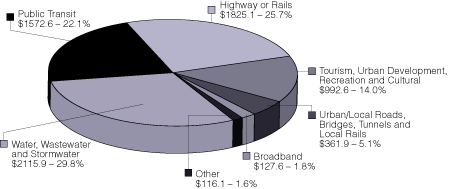
Total Funding for CSIF, BIF, ICP and MRIF Approved or Announced Projects: $7,111.8M
New CSIF/MRIF Federal/Provincial/Territorial Agreements
Entering into formal agreements with federal, provincial and territorial partners sets the foundation for successful delivery of planned programming and the achievement of the Government’s infrastructure priorities.
In addition to existing Memoranda of Understanding (MOUs) with other government departments, in 2006-2007, Infrastructure Canada completed a total of seven MOUs with Indian and Northern Affairs Canada (for Nunavut, the Northwest Territories and the Yukon) and with the Atlantic Canada Opportunities Agency (for New Brunswick, Prince Edward Island, Nova Scotia and Newfoundland and Labrador) to deliver CSIF funds.
Infrastructure Canada concluded the final federal-provincial agreement for the delivery of MRIF with the signing of the agreement with the Province of British Columbia in June 2006. In addition, arrangements with federal delivery partners were finalized with the signing of three MOUs: Industry Canada (for Ontario), Western Economic Diversification Canada (for British Columbia and for Alberta) and Canada Economic Development for Quebec Regions.
The Gas Tax Fund (GTF) and the Public Transit Fund (PTF)
In Budget 2005, the Government announced that $5 billion would be provided for the benefit of municipalities over five years by sharing a portion of the federal gas tax revenues. Budget 2007 commits to extending the federal GTF an additional four years until 2013-2014, delivering $8 billion in new predictable funding for sustainable infrastructure in our cities and communities. This funding enables municipalities to make investments in infrastructure projects that address local needs and help to produce the shared national outcomes of cleaner water, cleaner air and reduced greenhouse gas emissions.
Through the Public Transit Fund, the Government of Canada provided $400 million, allocated over two years, to support investments in public transit infrastructure in cities and communities. These funds support environmental outcomes of cleaner air and lowered greenhouse gas emissions.
The two programs involve agreements with all provincial and territorial governments, two municipal associations and the City of Toronto. In 2006-2007, provincial and territorial GTF signatories received $590.2 million and provincial and territorial PTF signatories received $19.1 million.
In 2006-2007, all outstanding provincial/territorial GTF and PTF funding agreements were signed and Oversight Committees established. These included the GTF agreement with Newfoundland and Labrador and PTF agreements with Newfoundland and Labrador, Nova Scotia, Nunavut and the Northwest Territories. Infrastructure Canada continued negotiations with the Province of Ontario for the distribution of $5.8 million in gas tax funds set aside for the benefit of Ontario’s unincorporated areas. Funding is expected to flow in 2007-2008.
GTF and PTF agreements describe the expected final outcomes of cleaner air, cleaner water and reduced greenhouse gas emissions. In 2006-2007, work began to identify appropriate outcome indicators that will meet the reporting requirements for these agreements. Both internal and contracted research, supplemented with advice from Fund signatories and other federal government departments, were used to develop a proposed performance measurement approach and specific municipal project environmental indicators. In 2007-2008, final indicators will be agreed upon through the individual Oversight Committees for use in the 2009 outcome reports.
Annual GTF expenditure reports for 2005-2006 were received from most signatories in the fall of 2006. These reports included the amounts paid to eligible recipients and demonstrated their ongoing eligibility under the GTF. The Department is working with the twooutstanding jurisdictions to address their capacity to deliver their reports so that transfers can resume.
The first PTF reports are not expected until the fall 2007.
GTF and MRIF Programming for First Nations
In 2006-2007, Infrastructure Canada continued working with Indian and Northern Affairs Canada (INAC) and the Assembly of First Nations to develop a program for the delivery of the First Nation components of the GTF and MRIF that are adapted to the particular infrastructure needs of First Nations communities.
Horizontal Approach for Reporting
In establishing a common, horizontal approach for reporting all federal infrastructure programs, Infrastructure Canada’s objective is to measure and report on progress and results as consistently as possible. The Department has developed preliminary performance measurement framework for the Gas Tax and Public Transit Funds which can be used as a basis for further discussion of common issues and data gaps.
Priority 2: Developing Policy, Knowledge and Partnerships
Policy Development
Infrastructure Canada works to support public infrastructure needs through the development of strategic policies that are based on sound knowledge and strong partnerships and address existing and emerging challenges and opportunities. In 2006-2007, Infrastructure Canada continued to deliver high quality and timely policy support and advice to the Minister and to develop strategic policies based on sound knowledge and strong partnerships. Some results achieved include:
- Leading the development of the Building Canada Infrastructure Plan announced in Budget 2007, tabled in the House of Commons in March 2007;
- Completing a series of fiscal balance consultations during the summer of 2006 with provinces, territories and other stakeholders to help shape the infrastructure programs contained in the Building Canada Infrastructure Plan;
- Conducting interim due diligence studies and providing project selection advice to the Minister; and
- Providing parliamentary and cabinet support to the Minister to ensure that Infrastructure Canada perspectives are incorporated in relevant Parliamentary, Cabinet, interdepartmental and portfolio briefing and policy documents.
Knowledge and Partnerships Development
Infrastructure Canada undertook research activities in all major program activity areas, in consideration of its research priorities. Multiple research studies were completed and disseminated on these issues. Details can be found in Section II and at: http://www.infrastructure.gc.ca/research-recherche/result/studies-rapports/index_e.shtml.
In June 2004, Infrastructure Canada received Treasury Board approval for two multidisciplinary policy research funding programs that support the organization’s Research Strategy goals. These programs are complementary tools to encourage and support the development of evidence-based policy and informed decision-making on public infrastructure and communities issues:
- Knowledge-building, Outreach and Awareness (KOA): http://www.infrastructure.gc.ca/research-recherche/fun-fin/koa-dcsc/index_e.shtml; and
- Peer-Reviewed Research Studies (PRRS): http://www.infrastructure.gc.ca/research-recherche/fun-fin/prrs-erep/index_e.shtml.
To date, these two research programs have funded more than 50 research projects and partnerships. During 2006-2007, competitive calls for proposals were conducted under both programs and agreements were signed to fund 14 new research projects, representing an investment of $1.3 million in research over the next two fiscal years.
Building Relationships and Sharing Knowledge
On behalf of the Government of Canada, Infrastructure Canada works with its partners to identify and assess public infrastructure needs, to evaluate priorities and to develop policy options to improve Government of Canada’s policies and programs in support of building modern public infrastructure and stronger cities and communities. Infrastructure Canada also seeks to build capacity and to develop and share knowledge about infrastructure with its partners through research, communications and other partnership initiatives. For example, Infrastructure Canada engages in ongoing liaison and information-sharing with provincial and territorial officials responsible for local government and for infrastructure through the Intergovernmental Consultation Network.
The Horizontal Research Roundtable on Infrastructure (HRRI) brings together about 25 federal government departments and organizations to facilitate and foster collaborative research on infrastructure. An intra-web portal for the HRRI was created in April 2006, for the use of HRRI members and federal government employees, to facilitate the activities of the HRRI and related research collaboration among its members.
1.3.3 Operating Environment and Challenges
Evolution of the Organization
Since it was established in 2002, Infrastructure Canada has overseen the relatively rapid development and implementation of three generations of infrastructure and communities programming. In 2004, Infrastructure Canada became a federal focal point for infrastructure and cities and communities issues. In February 2006, Infrastructure Canada and Transport Canada became part of a new portfolio: Transport, Infrastructure and Communities.
The evolution of Infrastructure Canada’s responsibilities over the past several years has resulted in a period of continuous change in its organizational structure and scope, creating demands for resources not anticipated at the time the organization was originally established. As a result, Infrastructure Canada has had to develop the capacity and operational structure to support new and expanded programs and provide an increasingly higher level of discipline and rigour to the policy development, project selection, program management and implementation processes, as well as audit and program/project evaluation.
Evaluating Effectiveness
Infrastructure Canada retains responsibility within the federal government for the use of contributions from its infrastructure funds and exercises due diligence and rigorous oversight. However, several factors may preclude the availability of information on program results, in turn affecting Infrastructure Canada’s ability to demonstrate tangible progress and results in the short term. For example, the long-term benefits of many of the infrastructure funding programs, such as economic and environmental benefits, may become apparent only after several years, given the long life cycle of major infrastructure projects. In addition, building sustained relationships with partners based on shared values, open communications and accountability is a long-term commitment. Over the years, there has been continued refinement of infrastructure programs that reflect the experience gained by the Government of Canada in the establishment of infrastructure programs; e.g., ICP in 2000 and CSIF and BIF in 2001. In 2002, the creation of Infrastructure Canada was followed by renewed investments in CSIF, the creation of the MRIF in 2003 and the establishment of the gas tax and public transit programs in 2005. Since then, the government has continued to pursue this evolution of a long-term, strategic commitment to infrastructure.
Ensuring Accountability
While Infrastructure Canada is fully accountable for program expenditures, the projects are managed collaboratively under the terms of specific Memoranda of Understanding (MOUs). As the coordinator and funding agent, Infrastructure Canada is responsible for project review, selection and approval, negotiation of the contribution agreement, and ongoing monitoring and oversight for the CSIF and BIF. For CSIF- and BIF-related transport projects, Transport Canada takes the lead responsibility for the above listed activities and Infrastructure Canada participates in a supportive role. Project review, selection and approval, and ongoing monitoring and oversight for the ICP and MRIF are the responsibility of the federal delivery partners. For GTF and PTF, expenditure reports are submitted to the department to identify the amounts paid to ultimate recipients and to demonstrate the recipients’ ongoing eligibility.
Coordination, Partnerships and Capacity Building
Coordination, partnerships and capacity building are at the core of Infrastructure Canada’s mandate, operations and organizational culture.
At the operating level, Infrastructure Canada collaborates extensively with other federal departments and agencies to deliver beneficial infrastructure programs for Canadians. Infrastructure Canada takes a leading role in developing and maintaining new partnerships and working relationships with the provinces, territories, municipalities, municipal associations and stakeholder organizations across the country, as well as with First Nations and international organizations. Significant challenges exist in addressing different goals of stakeholders while moving forward federal infrastructure objectives. Coordinating partnerships is also resource intensive.
Partnerships are also an important tool in Infrastructure Canada’s focus on knowledge generation, community building and knowledge transfer. Infrastructure Canada collaborates with other federal departments, other levels of government, universities, research institutes, civil society organizations, the private sector and other experts domestically and internationally to generate and share knowledge about infrastructure and communities in support of sound policy making.
1.3.4 Link to the Government of Canada Outcomes Areas
The whole-of-government framework for reporting Canada’s performance groups all departmental Strategic Outcomes and Program Activities into four broad Spending Areas: Economic Affairs, Social Affairs, International Affairs and Government Affairs.
Infrastructure Canada’s one Strategic Outcome and two corresponding Program Activities6 align with the Government of Canada Outcomes as shown in Figure 1B.
Figure 1B: Infrastructure Canada’s Linkage to the Whole-of-Government Performance Framework
|
Government of Canada |
Infrastructure Canada |
||
|
Spending Area |
Outcome |
Program Activity |
Strategic Outcome |
|---|---|---|---|
|
Economic Affairs |
Strong Economic Growth |
Infrastructure Investments |
Improving the sustainability of our cities and communities and Canada’s local, regional and national public infrastructure to enhance the economic, social, cultural and environmental quality of life of Canadians. |
|
An Innovative and Knowledge-based Economy |
Policy, Knowledge and Partnership Development |
||
For more information about the Government of Canada’s four broad Spending Areas and the corresponding 13 Outcomes, visit http://www.tbs-sct.gc.ca/rma/krc/cp-rc-1-05_e.asp.
5 Advantage Canada is a long-term, national economic plan designed to make Canada a true world economic leader.
6 The resources for Infrastructure Canada’s third Program Activity, Departmental Administration, are prorated to its other two Program Activities.
Section II: Analysis of Program Activities by Strategic Outcome
Analysis of Program Activities
Infrastructure Canada’s mission is to build world-class public infrastructure that contributes to Canada’s economic growth, a clean environment and strong communities for Canadians.
In carrying out this Government of Canada priority, Infrastructure Canada manages a suite of funding programs and works to build the policies, knowledge and partnerships to support them. The Government maximizes value for taxpayers’ money by supporting infrastructure projects that adhere to best practices, ensuring complementarity with investments from other orders of government and sectors and by requiring all funding recipients to be accountable.
Strategic Outcome: Improving the sustainability of our cities and communities and Canada’s local, regional and national public infrastructure to enhance the economic, social, cultural and environmental quality of life of Canadians.
Infrastructure Canada has one Strategic Outcome that is long-term and enduring in nature. It identifies the organization’s areas of influence and demonstrates how the Department’s efforts benefit Canadians and contribute to Government priorities. Infrastructure Canada’s Strategic Outcome will be achieved by:
- Strategically investing and leveraging other investments in sustainable public infrastructure;
- Fostering effective, new and innovative types of partnerships;
- Providing federal leadership for infrastructure and community issues; and
- Advancing policies and building, connecting and sharing knowledge.
Infrastructure Canada has established the following three Program Activities:
- Infrastructure Investments: See paragraph 2.1 for details.
- Policy, Knowledge and Partnership Development: See paragraph 2.2 for details.
- Departmental Administration: See Section IV for details.
2.1 Program Activity 1: Infrastructure Investments
Table 2.1: Financial Resources ($ thousands)
|
Planned Spending |
Authorities |
Actual Spending |
|---|---|---|
|
2,448,418 |
2,109,215 |
1,455,063 |
Table 2.2: Human Resources (FTEs)
|
Planned |
Actual |
Difference |
|---|---|---|
|
147 |
121 |
26 |
In support of its priority to deliver or coordinate approved program funding, Infrastructure Canada manages and leverages investments in public infrastructure to improve the state of Canada’s public infrastructure and, in turn, to promote economic growth, a clean environment and strong communities. The Department works in a coordinated manner with other federal departments and regional development agencies, provincial, territorial and municipal governments, First Nations and municipal associations to deliver approved program funding. Currently the six federal partners responsible for program delivery are: Western Economic Diversification Canada (for projects in the western provinces); Industry Canada (for projects in Ontario); Canada Economic Development for Quebec Regions (for projects in Quebec); the Atlantic Canada Opportunities Agency (for projects in the Atlantic provinces); Transport Canada (for transportation-related projects); and Indian and Northern Affairs Canada (for projects in the provinces that involve First Nations and projects in the three territories).
This Program Activity consists of all infrastructure programming delivered through transfer payments as well as the related program management and monitoring functions.
Canada Strategic Infrastructure Fund (CSIF)
The CSIF operates under the authority of the Canada Strategic Infrastructure Fund Act. It is directed to projects of major federal and regional significance in areas that are vital to sustaining economic growth and enhancing the quality of life of Canadians.
CSIF investments are made in cooperation with the provinces, territories, municipalities and the private sector. Each project is governed by specifically tailored arrangements with partners. Maximum federal funding is set at 50 per cent of total eligible project costs, except for broadband and northern infrastructure projects, for which federal funding can go to a maximum of 75 per cent. Typically, project costs are shared equally among the three orders of government at one-third each.
Ten per cent of the CSIF allocation is targeted for projects identified as national priority projects. The CSIF has supported large-scale national projects that include the Red River Floodway project in Manitoba, the National Satellite Initiative to provide broadband access to northern and remote communities and the twinning of the Trans-Canada Highway in Banff National Park in Alberta. For more information about CSIF projects, visit http://www.infrastructure.gc.ca/ip-pi/csif-fcis/proj/proj_desc_prov_e.shtml.
Results Achieved
In addition to existing Memoranda of Understanding (MOUs), in 2006-2007, Infrastructure Canada completed a total of seven MOUs to deliver CSIF funds, with Indian and Northern Affairs Canada (INAC) and with the Atlantic Canada Opportunities Agency (ACOA):
- INAC for Nunavut, Northwest Territories and Yukon, all signed September 15, 2006; and
- ACOA for New Brunswick, Prince Edward Island, Nova Scotia and Newfoundland and Labrador, all signed October 20, 2006.
During 2006-2007, 16 new projects were announced with a total federal contribution of $924.1 million. These included several highway projects in Prince Edward Island, Nova Scotia and Alberta, a national soccer stadium in Toronto and the continued expansion of the Manitoba Red River Floodway. Information on federal CSIF funding commitments is provided in Table 2.3.
Since the CSIF was established in 2001, 65 projects have been announced totalling more than $4 billion in federal contributions and contribution agreements (establishing the legal basis for federal payments on projects) have been signed for 40 projects. Figure 2A illustrates the breakdown of CSIF projects by investment category.
Additional information concerning the breakdown of CSIF projects announced in 2006-2007, by province and category, is shown in Tables 4.1 and 4.2 in Section IV.
Table 2.3: Federal Funding Commitments for CSIF
|
Category |
Number of Projects Announced in 2006-2007 |
Total Federal Funds Allocated in 2006-2007 ($M) |
Number of Projects Announced as of March 31, 2007 |
Total Federal Funds Allocated as of March 31, 2007 ($M) |
|---|---|---|---|---|
|
Water |
1 |
58.5 |
2 |
85.8 |
|
Wastewater |
2 |
35.6 |
13 |
288.6 |
|
Urban Roads |
- |
- |
1 |
13.0 |
|
Highways or Rail |
7 |
394.5 |
22 |
1,338.0 |
|
Public Transit |
2 |
178.0 |
7 |
1,498.0 |
|
Broadband |
- |
- |
4 |
113.4 |
|
Flood Control |
2 |
212.5 |
1 |
332.5 |
|
Housing |
- |
- |
1 |
20.0 |
|
Tourism |
2 |
45.0 |
14 |
474.7 |
|
Total |
16 |
924.1 |
65 |
4,164.01 |
Notes:
- Columns may not add due to rounding.
- Six Projects were announced in the 2005-2006 DPR as “Priority for funding announced”; this fiscal year they were announced as “Announcement of commitment to fund”.
1 Total does not include Federal Coordination and Research of $187M or the $50M Transfer to Parks Canada for the highway through Banff National Park.
Figure 2A: CSIF Funding Allocated to Projects, by Investment Category as of March 31, 2007 (%)
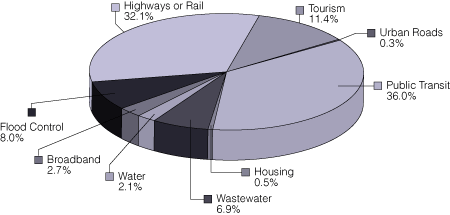
Total Federal Share of CSIF Announced Projects: $4,164M
Note:
- Total does not include Federal Coordination and Research of $187M or the $50M Transfer to Parks Canada for the highway through Banff National Park.
Border Infrastructure Fund (BIF)
The $600-million BIF was established in 2001 to target improvements primarily to the six largest surface border crossings between Canada and the United States, as well as improvements to several other crossings. It has provided funding for investments in physical infrastructure, intelligent transportation system infrastructure and improved analytical capacity. BIF investments in border infrastructure are critical to Canada’s growing economic and trade relationship with the United States and reflect the importance of Canada’s border crossings, ports and highway approaches to economic growth, trade and security, both nationally and as international gateways. There are no set jurisdictional allocations for this Fund.
Results Achieved
During 2006-2007, three new BIF projects were announced, with a total federal contribution of $72 million. Since its inception, 11 projects have been announced totalling $535.1 million in federal contributions. A summary of BIF expenditures is provided in Table 2.4. For more information about BIF projects, visit http://www.infrastructure.gc.ca/ip-pi/bif-fsif/proj/proj_desc_prov_e.shtml.
Additional information concerning BIF projects, by category and province/territory, is shown in Tables 4.3 and 4.4 in Section IV.
Table 2.4: Federal Funding Commitments for BIF
|
Category |
Number of Projects Announced in 2006-2007 |
Total Federal Funds Allocated in 2006-2007 ($M) |
Number of Projects Announced as of March 31, 2007 |
Total Federal Funds Allocated as of March 31, 2007 ($M) |
|---|---|---|---|---|
|
Physical Infrastructure |
3 |
72.0 |
10 |
531.0 |
|
Improve Analytical Capacity |
- |
- |
- |
- |
|
Intelligent Transportation System Infrastructure |
- |
- |
1 |
4.1 |
|
Total |
3 |
72.0 |
11 |
535.1 |
Notes:
- Columns may not add due to rounding.
- All Projects were announced in the 2005-2006 DPR as “Priority for funding announced”; this fiscal year they were announced as “Announcement of commitment to fund”.
- The total allocation for BIF excludes $3 million which was transferred to the Canada Border Services Agency for the Border Modelling project and $15 million which was transferred for the new border facility at St. Stephen, New Brunswick.
Infrastructure Canada Program (ICP)
The $2.05-billion ICP, including the Canada-Ontario Infrastructure Program (COIP), was created in 2000 to enhance infrastructure in Canada’s urban and rural communities and to improve the quality of life of Canadians through investments that protect the environment and support long-term community and economic growth. Funding was transferred, at the beginning of the program, to the federal delivery partners whose ministers are accountable for delivery of the program. While each of the federal ministers heading these departments has financial and parliamentary responsibility for program delivery, the Minister responsible for Infrastructure Canada is responsible for the overall policy and coordination aspects including maintenance of the Shared Information Management System for Infrastructure (SIMSI)) and the required program evaluation.
As of March 31, 2007, virtually all ICP funding was committed and 3,883 projects across Canada have been approved. To provide more time to complete scheduled projects, this Program was extended to March 31, 2009 and March 31, 2007 for the First Nations component. However, no additional funding was provided.
The priority for the ICP has been to support “green” municipal infrastructure, consistent with the Government’s sustainable development objective. A minimum of 50 per cent of federal ICP expenditures is devoted to such projects as water and wastewater systems, solid waste management and recycling and capital expenditures to retrofit or improve the energy efficiency of buildings and facilities owned by local governments. Other ICP priorities include local transportation infrastructure, cultural and recreational facilities, rural and remote telecommunications and affordable housing.
Results Achieved
During 2006-2007, 12 new ICP projects were approved, with a total federal contribution of $2.7 million. Since its inception, 3883 projects have been approved totalling nearly $2 billion in federal contributions. Because the life cycle of major infrastructure projects is long, results indicators for completed ICP projects are currently not available. A summary of federal funds allocated by ICP categories is provided in Table 2.5. Figure 2B illustrates how the ICP projects approved as of March 31, 2007, are distributed by investment category. For more information about ICP projects, visit http://www.infrastructure.gc.ca/ip-pi/icp-pic/projects-projets/index_e.shtml.
The total investment in community infrastructure generated by ICP to date exceeds the original goal by 30 per cent. The federal contribution leveraged nearly $6 billion of total investment in community infrastructure from other levels of government. As determined by the mid-term evaluation of the ICP, the Program has also achieved an appropriate balance of federal and provincial priorities. To view a summary of the evaluation, visit http://www.infrastructure.gc.ca/pd-dp/eval/me_icp_2006_e.shtml.
Additional information concerning ICP projects, by province/territory, is shown in Table 4.5 in Section IV.
Table 2.5: Federal Funding Commitments for ICP
|
Category |
Number of Projects Approved in 2006-2007 |
Total Federal Funds Allocated in 2006-2007 ($M) |
Number of Projects Approved as of March 31, 2007 |
Total Federal Funds Allocated as of March 31, 2007 ($M) |
|---|---|---|---|---|
|
Green Municipal |
12 |
2.7 |
2,429 |
1,050.0 |
|
Local Transportation |
- |
- |
731 |
421.9 |
|
Cultural and Recreational |
- |
- |
611 |
355.0 |
|
High-Speed Access for Public Institutions |
- |
- |
3 |
9.2 |
|
Rural and Remote Telecommunications |
- |
- |
5 |
0.7 |
|
Affordable Housing |
- |
- |
7 |
6.8 |
|
Tourism |
- |
- |
61 |
78.7 |
|
Other |
- |
- |
36 |
15.4 |
|
Total |
12 |
2.7 |
3,883 |
1,937.6 |
Note:
- Columns may not add due to rounding.
Figure 2B: ICP Funding Allocated to Projects, by Investment Category as of March 31, 2007 (%)
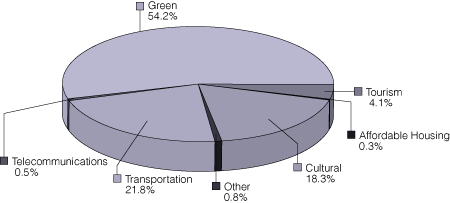
Total Federal Share of ICP Approved Projects: $1,937.6M
Municipal Rural Infrastructure Fund (MRIF)
Reflecting the Government’s commitment to urban and rural growth, the $1-billion MRIF, created in 2001, focuses on smaller-scale municipal infrastructure projects that support sustainable development, improved quality of life and economic opportunities and increased connectivity for smaller and rural communities. A minimum of 60 per cent of the MRIF’s nation-wide expenditures is devoted to projects addressing environmental quality objectives such as water and wastewater treatment. MRIF also supports roads, bridges, cultural and recreation infrastructure in communities across Canada. The MRIF also has a component to address the infrastructure needs of First Nations communities.
As part of its infrastructure investment activities, Infrastructure Canada also works to build capacity and generate knowledge on infrastructure and community issues working with municipalities and other partners. Up to one per cent of the jurisdictional allocation under the MRIF is available for a Municipal Capacity Building component that seeks to encourage the use of integrated asset management by small-scale Canadian municipalities. The goal of this component is to promote the implementation of integrated approaches to public infrastructure planning and management; encourage the use of asset management in support of decision making; promote the integration of demand management in public infrastructure planning and management; and encourages the sharing of project results with other municipalities and the public.
Results Achieved
Infrastructure Canada concluded the final federal-provincial agreement for the delivery of MRIF with the signing of the agreement with the Province of British Columbia in June 2006. In addition, arrangements with federal delivery partners were finalized with the signing of three MOUs:
- Industry Canada for Ontario projects, on August 14, 2006;
- Western Economic Diversification Canada, for the provinces of British Columbia and Alberta, each signed on September 5, 2006; and
- Canada Economic Development for Quebec Regions, on March 6, 2007.
During 2006-2007, 636 new MRIF projects were approved, with a total federal contribution of $443.9 million. Information on federal MRIF funding commitments is provided in Table 2.6. Since the MRIF was established in 2001, 963 projects have been approved, totalling $648.2 million in federal contributions. Figure 2C illustrates how the MRIF projects approved as of March 31, 2007, are distributed by investment category. For more information about MRIF projects, visit http://www.infrastructure.gc.ca/ip-pi/mrif-fimr/projects-projets/index_e.shtml. Additional information concerning MRIF projects, by province/territory, is shown in Table 4.6 in Section IV.
Table 2.6: Federal Funding Commitments for MRIF
|
Category |
Number of Projects Approved in 2006-2007 |
Total Federal Funds Allocated in 2006-2007 ($M) |
Number of Projects Approved as of March 31, 2007 |
Total Federal Funds Allocated as of March 31, 2007 ($M) |
|---|---|---|---|---|
|
Water |
190 |
105.4 |
251 |
159.9 |
|
Wastewater |
171 |
152.4 |
261 |
227.4 |
|
Solid Waste |
23 |
8.1 |
35 |
10.1 |
|
Environmental Energy Improvements |
7 |
12.2 |
12 |
16.0 |
|
Local Roads |
196 |
82.1 |
322 |
128.1 |
|
Public Transit |
4 |
7.9 |
4 |
7.9 |
|
Cultural |
32 |
11.5 |
40 |
13.0 |
|
Recreation |
55 |
53.4 |
74 |
65.0 |
|
Connectivity |
3 |
2.0 |
5 |
4.4 |
|
Tourism |
2 |
0.8 |
6 |
6.3 |
|
Municipal Capacity Building |
5 |
0.2 |
6 |
0.6 |
|
Service Infrastructure |
4 |
8.0 |
5 |
9.5 |
|
Total |
6361 |
443.9 |
9631 |
648.2 |
Note:
- Columns may not add due to rounding.
1 Column does not add to total because some projects involve multiple categories and have been counted twice.
Figure 2C: MRIF Funding Allocated to Projects, by Investment Category as of March 31, 2007 (%)
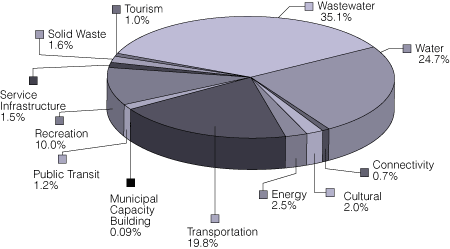
Total Federal Share of MRIF Approved Projects: $648.2M
Green Projects and Green Objectives
Infrastructure Canada is committed to achieving green objectives in the funding programs it delivers or coordinates. For local infrastructure projects to be considered “green”, they must improve the quality of the environment and contribute to cleaner water, soil or air, or improve the quality of human life. Each green project must fall into one of these categories: water, wastewater, solid waste, public transit, or energy efficiency. Over half of projects and funds are directly supporting green objectives.
Gas Tax Fund (GTF)
In Budget 2005, the Government announced that $5 billion would be provided for the benefit of municipalities over five years by sharing a portion of federal gas tax revenues. The goal of the GTF is to provide reliable and predictable multi-year funding to municipalities to achieve national environmental outcomes of cleaner air, cleaner water and reduced greenhouse gas emissions. These objectives involve capital investments in public transit, water and wastewater treatment, solid waste management, community energy systems and local roads and bridges. Budget 2006 confirmed this funding commitment for the remaining four years. Budget 2007, tabled in March, plans to extend the GTF until 2014, adding new funding for a total of $13 billion since its inception.
Flexible, long-term GTF funding enables municipalities to initiate projects quickly, to make investments in infrastructure that address local needs and to help contribute to the achievement of national environmental outcomes. The GTF also includes a capacity building component to help municipal jurisdictions to develop integrated community sustainability plans (ICSP) which is a key component of each GTF agreement. An ICSP is a long-term plan, developed in consultation with community members, which provides direction to help the community realize its sustainability objectives for the environment and the cultural, social and economic dimensions of its identity. Provinces and territories have agreed that, over the life of the GTF agreements, they would ensure the development of the ICSP or approved equivalent plan, either by a local government or at some higher level appropriate to the province or territory.
Results Achieved
In 2006-2007, the last of the GTF agreements was signed with Newfoundland and Labrador on August 1, 2006. Infrastructure Canada continued negotiations with the Province of Ontario for the distribution of $5.8 million in gas tax funds, set aside for the benefit of Ontario’s unincorporated areas. Funding is expected to flow in early 2007-2008. In 2006-2007, provincial and territorial GTF signatories received $590.2 million.
Table 2.7 provides a breakdown of the 252 funded projects and Figure 2D displays the GTF investment by category for 2005-2006 which is the latest information by category available for the program. Further, Table 4.7 in Section IV provides additional information, by province/territory, concerning the GTF.
During 2006-2007, Infrastructure Canada consulted with provincial and territorial officials concerning ICSPs, as part of regularly scheduled GTF Oversight Committee meetings established to monitor overall strategic implementation of the agreements, discuss implementation issues and key activities in the provinces and territories, coordinate planning for future collaborations and make decisions when required. Infrastructure Canada also organized a workshop for all GTF signatories in December 2006, to clarify the obligations of the parties, exchange views, discuss implementation issues, share best practices and strengthen networking.
For additional information concerning these agreements and allocations, visit, http://www.infrastructure.gc.ca/communities-collectivites/agreements-ententes/gas-essence_tax/index_e.shtml.
Table 2.7: GTF Project Funding by Category 2005-20061
|
Category |
Number of Category Projects Funded |
GTF Spent ($M) |
|---|---|---|
|
Capacity Building |
4 |
0.8 |
|
Community Energy Systems |
10 |
1.3 |
|
Local Roads and Bridges |
93 |
8.8 |
|
Public Transit |
32 |
87.7 |
|
Solid Waste |
13 |
7.3 |
|
Water |
28 |
3.0 |
|
Wastewater |
72 |
7.3 |
|
Total |
252 |
116.2 |
Figure 2D: GTF Investments by Category 2005-2006 (%)
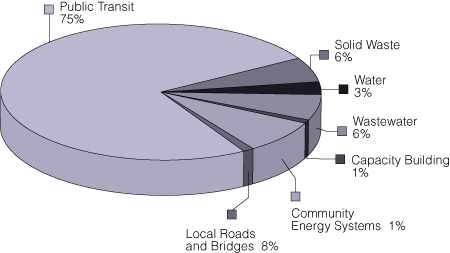
Public Transit Fund (PTF)
The PTF provides $400 million, allocated over two years, to support projects that provide better and more flexible public transportation options for Canadians, thereby reducing congestion, reducing greenhouse gas emissions, reducing airborne pollutants and improving the quality of the environment. Funds are transferred to municipalities or other eligible recipients through agreements between Canada and the provinces and territories. Allocation in most jurisdictions is based primarily on transit ridership.
Results Achieved
In 2006-2007, all outstanding provincial and territorial funding agreements for the PTF were signed:
- The Newfoundland and Labrador agreement was signed on March 30, 2007;
- The Nova Scotia agreement was signed on November 24, 2006;
- The Nunavut agreement was signed on December 1, 2006; and
- The Northwest Territories agreement was signed on March 31, 2007.
In 2006-2007, provincial and territorial PTF signatories received $19.1 million.
For additional information concerning these agreements and allocations, visit http://www.infrastructure.gc.ca/communities-collectivites/agreements-ententes/public_trans_commun/index_e.shtml.
2.2 Program Activity 2: Policy, Knowledge and Partnership Development
Table 2.8: Financial Resources ($ thousands)
|
Planned Spending |
Authorities |
Actual Spending |
|---|---|---|
|
17,401 |
18,428 |
13,773 |
Table 2.9: Human Resources (FTEs)
|
Planned |
Actual |
Difference |
|---|---|---|
|
73 |
63 |
10 |
Policy Development
Infrastructure Canada works with its partners to identify and assess public infrastructure needs, to evaluate priorities and funding pressures and to develop policy options for the Minister’s consideration.
Results Achieved
In 2006-2007, Infrastructure Canada continued to deliver high quality and timely policy support and advice to develop strategic policies based on sound knowledge and strong partnerships.
Specific results achieved include:
- Providing policy support to the Minister through the consultations on and development of, a long-term comprehensive infrastructure plan to meet Canada’s infrastructure needs and provide stable, predictable and long-term infrastructure funding to provinces, territories and municipalities. The result of this process, the Building Canada Infrastructure Plan, was
announced in Budget 2007 as part of an unprecedented seven year, $33 billion investment for public infrastructure of various types across Canada;
- Conducting interim due diligence studies of the funding eligibility of project proposals under CSIF and BIF and providing project selection advice, based on the due diligence process, to the Minister;
- Providing ongoing policy support, advice and timely information to the Minister on broad infrastructure policy and project priorities;
- Providing parliamentary and cabinet support to the Minister to ensure that Infrastructure Canada perspectives are incorporated in relevant Parliamentary, Cabinet, interdepartmental and portfolio briefing and policy documents; and
- Continuing to maintain, foster and enhance strong partnerships with federal departments and key stakeholders through ongoing and regular consultation and discussion.
Knowledge and Partnership Development
Infrastructure Canada, with its partners, seeks to build capacity and develop and share knowledge about infrastructure, cities and communities through research, communications and partnership initiatives. This program recognizes the need to improve our understanding of Canada’s public infrastructure and develop, in partnership with others, best practices to improve the safety and efficiency of how Canada’s infrastructure is built and maintained. During the reporting period, Infrastructure Canada had six main research priorities:
- The state of infrastructure in Canada’s communities;
- Communities, cities and public infrastructure;
- The economic, social, cultural and environmental impacts of public infrastructure on communities;
- Financing mechanisms for public infrastructure and communities;
- Technology, innovation and transformative infrastructure; and
- Governance issues related to public infrastructure and communities.
In each of these areas, specific issues had been identified in light of Infrastructure Canada’s short-term and medium-term policy and operational activities. These issues were communicated publicly on the organization’s Research Gateway at http://www.infrastructure.gc.ca/research-recherche/index_e.shtml.
The cornerstone of Infrastructure Canada’s research role is the Research Strategy, with its three objectives:
- Knowledge generation: To create new, more multi-disciplinary insights on infrastructure, cities and communities issues;
- Community building: To increase research capacity by fostering stronger research networks; and
- Knowledge transfer: To ensure research results are useable and available to researchers and policy-makers concerned with the sustainability of public infrastructure and communities.
Results Achieved
a) Knowledge Generation
Infrastructure Canada has developed its five-year research funding initiative to generate knowledge and complement its objectives on community building and knowledge transfer. This initiative comprises two programs:
- Knowledge-building, Outreach and Awareness (KOA) Program: In 2006-2007, Infrastructure Canada conducted the third call for KOA proposals. The Program was also used to provide targeted support to a research project led by the Commonwealth Local Government Forum. As a result, nine new contribution agreements were signed with a total value exceeding $800,000 to be disbursed during this and the following two fiscal years; and
- Peer-Reviewed Research Studies (PRRS) Program: In 2006-2007, Infrastructure Canada continued its relationship with the Social Sciences and Humanities Research Council and the Natural Sciences and Engineering Research Council, with the two granting councils assisting with the delivery of the Program, in particular the peer review process. In June 2006 the second call for proposals under the Program was launched and five successful proposals were selected for funding. However, only two of these proposals resulted in contribution agreements signed during the reporting period, with a combined value of more than $110,000, to be disbursed during the following two fiscal years. Agreements for the remaining three proposals will be finalized in early 2007-2008.
Figure 2E illustrates the distribution of KOA and PRRS projects by subject area, with a total funding allocation in excess of $8.4 million as of March 31, 2007.
Figure 2E: KOA and PRRS Contributions Allocated as of March 31, 2007. Total Value: $8.4 million
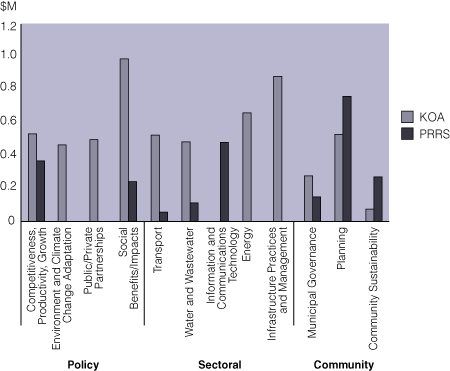
For more information about these two research programs visit http://www.infrastructure.gc.ca/research-recherche/fun-fin/index_e.shtml.
Infrastructure Canada completed 10 in-house research studies in 2006-2007 including The Path Towards Sustainability: An Evaluation of the “Sustainability-ness” of Selected Municipal Plans in Canada; Productivity and Infrastructure: A preliminary review of the literature; and Infrastructure and Identity: Building Canada – People and Projects that Shaped the Nation, that are available at http://www.infrastructure.gc.ca/research-recherche/result/index_e.shtml.
In 2006-2007, Infrastructure Canada finalized its work with Statistics Canada on three major projects that have resulted in the development of a robust concept of public infrastructure, as well as inventories of stocks and investments in infrastructure assets. The results of the three studies are posted on the Horizontal Research Roundtable on Infrastructure (HRRI) web portal, available to HRRI members and to federal government officials.
In 2006-2007, Infrastructure Canada successfully concluded its work on a two-year research project with the International Futures Program of the Organization for Economic Co-operation and Development (OECD). The international project examined the opportunities and challenges facing the infrastructure sector worldwide over the next 30 years, with the aim of developing policy recommendations for OECD governments to enhance the contribution of infrastructure to economic and social development. The results were included in the OECD report:
- Infrastructure to 2030: Telecom, Land Transport, Water and Electricity estimates global infrastructure needs over the next two decades and identifies the key challenges countries will face in meeting these needs. This report can be viewed at http://www.oecd.org/document/60/0,3343,en_2649_36240452_36964924_1_1_1_1,00.html.
The Department also completed its Infrastructure Canada – Canada West Foundation collaborative project. The resulting study report, New Tools for New Times – A Sourcebook for the Financing, Funding and Delivery of Urban Infrastructure, describes the winning conditions for a broad range of financing mechanisms for infrastructure development and assesses the suitability of these mechanisms in meeting specific municipal infrastructure needs and formats. The Sourcebook also presents some possible implications for the federal government. See this report at http://www.cwf.ca/V2/modules/map.php.
Infrastructure Canada provided administrative and research assistance to the External Advisory Committee on Cities and Communities (EACCC) until the completion of its final report, From Restless Communities to Resilient Places: Building a Stronger Future for All Canadians, submitted in June 2006. To view the Report, visit http://www.infrastructure.gc.ca/eaccc-ccevc/rep-rap/index_e.shtml.
b) Community Building
Infrastructure Canada is exploring ways to develop more effective and innovative intergovernmental relationships to help address the complex, inter-related challenges that affect Canada’s economic prosperity and quality of life.
In June 2006, the Alberta Trilateral Partnership on Community Sustainability was created. The partnership involves officials from federal and provincial government departments, the cities of Edmonton and Calgary and Alberta’s two municipal associations. Over the past year, working groups identified key issues and developed action plans in four priority areas: immigration and labour market; Wood Buffalo region; programs inventory; and affordable housing.
Infrastructure Canada played a leading role in Canada’s preparations to host the UN-HABITAT’s 3rd World Urban Forum, held in Vancouver in June 2006.
c) Knowledge Transfer
Over the past few years, Infrastructure Canada developed the Research Gateway to share infrastructure research and knowledge with researchers, policy-makers and other users. During 2006-2007, enhancements to the Research Gateway (see http://www.infrastructure.gc.ca/research-recherche/index_e.shtml) included new research studies, tools and links, as well as information about research projects funded through Infrastructure Canada’s two research funding programs. Additions and upgrades have also been made to the on-line Register of Research (see http://www.infrastructure.gc.ca/research-recherche/reg/index_e.shtml).
In 2006-2007 Infrastructure Canada continued to develop its federal research network. This consisted mainly of the working level HRRI. The objective of the HRRI is to undertake, collaborate on and share research on infrastructure, cities and communities and to ensure that research findings are effectively transferred to policy work and processes across the federal government. Infrastructure Canada hosted three HRRI events to share and develop knowledge in each of its research priority areas:
- In April 2006: Presentation on Costing Mechanisms to Facilitate Sustainable Community Planning;
- In September 2006: Presentation on Innovative Options for Financing, Funding and Providing Municipal Infrastructure by the Canada West Foundation; and
- Also in September 2006: Tools to Assess the Social and Cultural Impacts of Infrastructure on Communities.
Infrastructure Canada also established a new web portal for the HRRI to facilitate the activities of the roundtable and related research collaboration among its members. It features up-to-date research documentation and an evergreen calendar of upcoming HRRI and other infrastructure research events. Access to the web portal is restricted to HRRI members and Government of Canada officials.
These on-line resources were augmented by the InfraGuide project that identified and disseminated best practices, and encouraged innovation to support sustainable municipal infrastructure decisions and actions to protect and enhance the quality of life of Canadians. As this project concluded in February 2007, the Department is considering alternatives to achieve similar objectives on a continuing basis.
In 2006-2007, Infrastructure Canada hosted two workshops:
- Creating the Winning Conditions for Technological Innovation in Municipal Water and Wastewater Infrastructure – A Policy Discussion, in May 2006, as part of the Policy Research Initiative’s conference on Freshwater for the Future; and
- Research to Action, held at the end of November 2006, which brought together researchers from the two research funding programs, along with members of the HRRI and other federal government officials. Participants shared their research results and discussed the challenges and opportunities of applying these results at the policy level.
In 2006-2007, Infrastructure Canada continued its international collaboration to develop and maintain partnerships with multilateral organizations (OECD, World Bank, UN-HABITAT, Commonwealth Local Government Forum, etc.) and other nations to generate and communicate knowledge in support of sound policy making.
Infrastructure Canada also provided significant input and research assistance to the World Bank’s international pilot study to develop global city indicators. In January 2007, Infrastructure Canada hosted a workshop in Montreal for the participating cities to discuss and further develop the draft city indicators that are now being tested, with results to be presented by the World Bank at the World Urban Forum in 2008.
Section III: Supplementary Information
3.1 Organizational Information
The Honourable Lawrence Cannon is the Minister responsible for the Transport, Infrastructure and Communities portfolio.7
Infrastructure Canada is headed by a Deputy Head, Louis Ranger, who reports to the Minister. The Deputy Head was supported in 2006-2007 by five Assistant Deputy Ministers and a Departmental Senior Counsel:
- Senior Assistant Deputy Minister, Policy and Communication: John Forster
- Assistant Deputy Minister, Cities and Communities: Yazmine Laroche
- Assistant Deputy Minister, Program Operations: Carol Beal
- Assistant Deputy Minister, Corporate Services/Chief Financial Officer: David Cluff
- Assistant Deputy Minister, Regional Integration: Gary Webster
- Departmental Senior Counsel: Richard Ouellet
Infrastructure Canada’s organizational structure is presented in Figure 3A.
Figure 3A: Infrastructure Canada Organization Chart (March 31, 2007)
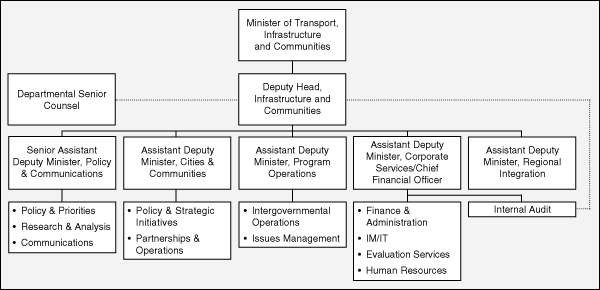
Departmental Partners
Infrastructure Canada collaborates with other federal departments and agencies to deliver its infrastructure programs; e.g., Indian and Northern Affairs Canada works with Infrastructure Canada to implement projects in the territories and those that involve First Nations in the provinces. Infrastructure Canada also works closely with Western Economic Diversification Canada, Industry Canada, Canada Economic Development for Quebec Regions, the Atlantic Canada Opportunities Agency and Transport Canada. Other federal partners include Environment Canada, Canada Mortgage and Housing Corporation and Public Works and Government Services Canada.
These departments and agencies share their knowledge of local needs and priorities, as well as their technical expertise, resources and governance structures and are critical to Infrastructure Canada’s ability to fulfill its mandate. For transport-related projects from the Canada Strategic Infrastructure Fund and the Border Infrastructure Fund, Transport Canada provides the federal lead role while Infrastructure Canada provides a supportive role.
In addition to federal partners, Infrastructure Canada collaborates with provincial, territorial and municipal governments and associations, as well as universities, research institutes, civil society organizations, the private sector and other experts. This collaboration is intended to:
- Generate new, horizontal insights into infrastructure and place-based issues;
- Develop a stronger, more multi-disciplinary research community that can provide support for policy and decision makers in the multiple sectors involved in addressing Canada’s infrastructure needs; and
- Gather, disseminate and communicate knowledge about infrastructure from and to key partners.
7 On February 6, 2006, Infrastructure Canada became part of the Transport, Infrastructure, and Communities Portfolio under the responsibility of the Minister of Transport, Infrastructure and Communities.
3.2 Supplementary Tables
Table 3.1: Comparison of Planned to Actual Spending (including Full-time Equivalents)
|
($ thousands) |
2004-2005 |
2005-2006 |
2006-2007 |
|||
|---|---|---|---|---|---|---|
|
Mai |
Planned |
Total |
Actual |
|||
|
Infrastructure Investments (Revised PAA) |
|
|
0 |
2,448,418 |
2,109,215 |
1,455,063 |
|
Policy, Knowledge and Partnership Development (Revised PAA) |
|
|
0 |
17,401 |
18,428 |
13,773 |
|
Infrastructure and Communities (Previous PAA) |
227,901 |
1,503,085 |
1,824,127 |
0 |
0 |
0 |
|
Crown Corporations Portfolio Management (Previous PAA) |
22,468 |
24,251 |
22,989 |
2,492 |
0 |
0 |
|
Total |
250,369 |
1,527,336 |
1,847,116 |
2,468,311 |
2,127,643 |
1,468,836 |
|
Plus: Cost of services received without charge |
0 |
2,440 |
|
1,967 |
|
2,298 |
|
Total Departmental Spending |
250,369 |
1,529,776 |
1,847,116 |
2,470,278 |
2,127,643 |
1,471,134 |
|
Full Time Equivalents |
179 |
180 |
|
220 |
|
184 |
Explanatory Notes:
- The variance between total authorities and actual spending in 2006-2007 is due mainly to two factors:
- finalization of contribution agreements for programs such as CSIF and BIF took longer than originally anticipated, therefore delaying the initiation of reimbursement of project claims to recipients;
- reduced cash requirements by recipients for the current year, based on cash flow projections for MRIF, BIF and CSIF.
- finalization of contribution agreements for programs such as CSIF and BIF took longer than originally anticipated, therefore delaying the initiation of reimbursement of project claims to recipients;
- All lapsed contribution funding in 2006-2007 will be carried forward to future years to align with recipient cash flow requirements.
Table 3.2: Use of Resources by Program Activities ($ thousands)
|
2006-2007 |
|||||
|
Program Activity – PA |
Budgetary |
Plus: Non-Budgetary |
Total |
||
|---|---|---|---|---|---|
|
Operating |
Grants and Contributions |
Total Budgetary |
Loans, Investments and Advance |
||
|
Infrastructure Investments (Revised PAA) |
|||||
|
Main Estimates |
|
|
0 |
0 |
0 |
|
Planned Spending |
27,943 |
2,420,475 |
2,448,418 |
0 |
2,448,418 |
|
Total Authorities |
29,166 |
2,080,049 |
2,109,215 |
0 |
2,109,215 |
|
Actual Spending |
25,903 |
1,429,160 |
1,455,063 |
0 |
1,455,063 |
|
Policy, Knowledge and Partnership Development (Revised PAA) |
|||||
|
Main Estimates |
|
|
0 |
0 |
0 |
|
Planned Spending |
12,196 |
5,205 |
17,401 |
0 |
17,401 |
|
Total Authorities |
13,271 |
5,157 |
18,428 |
0 |
18,428 |
|
Actual Spending |
9,142 |
4,631 |
13,773 |
0 |
13,773 |
|
Infrastructure and Communities (Previous PAA) |
|||||
|
Main Estimates |
36,958 |
1,787,169 |
1,824,127 |
0 |
1,824,127 |
|
Planned Spending |
0 |
0 |
0 |
0 |
0 |
|
Total Authorities |
0 |
0 |
0 |
0 |
0 |
|
Actual Spending |
0 |
0 |
0 |
0 |
0 |
|
Crown Corporations Portfolio Management (Previous PAA) |
|||||
|
Main Estimates |
20,497 |
0 |
20,497 |
2,492 |
22,989 |
|
Planned Spending |
0 |
0 |
0 |
2,492 |
2,492 |
|
Total Authorities |
0 |
0 |
0 |
0 |
0 |
|
Actual Spending |
0 |
0 |
0 |
0 |
0 |
|
Total Department |
|||||
|
Main Estimates |
57,455 |
1,787,169 |
1,844,624 |
2,492 |
1,847,116 |
|
Planned Spending |
40,139 |
2,425,680 |
2,465,819 |
2,492 |
2,468,311 |
|
Total Authorities |
42,437 |
2,085,206 |
2,127,643 |
0 |
2,127,643 |
|
Actual Spending |
35,044 |
1,433,792 |
1,468,836 |
0 |
1,468,836 |
Explanatory Notes:
- This table shows the realignment of the former Program Activity Architecture, as printed in the Main Estimates 2006-2007, to the new PAA, as printed in the Public Accounts for 2006-2007. This includes the impact of the transfer out of the Crown Corporation Portfolio Management to Transport Canada, and the creation of two new activities from the former Infrastructure and
Communities activity to better report on results.
- The variance between total authorities and actual spending is explained in Table 3.1 and is mostly attributable to the signing of contribution agreements later than originally anticipated, and cash flow adjustments requested by recipients.
Table 3.3: Voted and Statutory Items ($ thousands)
|
Vote or Statutory Item |
Truncated Vote or Statutory Wording |
2006-2007 |
|||
|---|---|---|---|---|---|
|
Main Estimates |
Planned Spending |
Total Authorities |
Actual |
||
|
55 |
Operating expenditures |
37,103 |
38,778 |
39,987 |
32,593 |
|
60 |
Contributions |
1,787,169 |
2,406,680 |
2,066,093 |
1,414,680 |
|
65 |
Payments to Old Port of Montreal Corporation Inc. |
18,800 |
0 |
0 |
0 |
|
L70 |
Payments to Queens Quay West Land Corporation |
2,492 |
2,492 |
0 |
0 |
|
(S) |
Payments to the Public Transit Fund |
|
19,000 |
19,112 |
19,112 |
|
(S) |
Contributions to Employee Benefit Plans |
1,552 |
1,361 |
2,451 |
2,451 |
|
|
Total Department |
1,847,116 |
2,468,311 |
2,127,643 |
1,468,836 |
Explanatory Notes:
- The lapse in Vote 55 – Operating budget is attributable partly to reduced salary spending reflecting a higher number of staff vacancies than anticipated, and reduced spending requirements following the transfer of the department to the Transport, Infrastructure and Communities portfolio, resulting in savings in the operations of a Minister’s Office and a Deputy
Head’s Office. The lower spending is also related to the slowdown in spending on the contribution management system
(SIMSI) due to the need to get the appropriate authorization and then the appropriate contract in place.
- The lapse in Vote 60 – Contributions is explained in the narrative for Table 3.1 and 3.2.
- Variances in Planned Spending compared to Actual Spending for Vote 65 and Vote L70 reflect the transfer of these Crown corporations to Transport Canada in 2006-2007.
Table 3.4: Services Received Without Charge ($ thousands)
|
|
2006‑2007 |
|---|---|
|
Accommodation provided by Public Works and Government Services Canada (PWGSC) |
1,122 |
|
Contributions covering employers’ share of employees’ insurance premiums and expenditures paid by TBS (excluding revolving funds) |
1,176 |
|
Total 2006-2007 Services received without charge |
2,298 |
Table 3.5: Details on Transfer Payment Programs (TPPs)
Infrastructure Canada managed the following Transfer Payment Programs in excess of $5 million:
- Contributions under the Canada Strategic Infrastructure Fund;
- Contributions under the Border Infrastructure Fund;
- Contributions under the Municipal Rural Infrastructure Fund;
- Transfer Payments under the Gas Tax Fund; and
- Contributions under the Public Transit Fund.
For further information on the above-mentioned transfer payment programs see: http://www.tbs-sct.gc.ca/dpr-rmr/0607/info/tpp-ppt_e.asp.
Table 3.6: Reporting on Horizontal Initiatives
The objective of reporting on Horizontal Initiatives is to provide Parliamentarians, the public and the government with an overall picture of public expenditures, plans, priorities and achievements for all major horizontal initiatives.
A Horizontal Initiative is an initiative in which partners from two or more organizations have agreed, under a formal funding agreement, to work towards the achievement of shared outcomes. Over the last year, Infrastructure Canada led in four horizontal initiatives; i.e., Canada Strategic Infrastructure Fund, Border Infrastructure Fund, Municipal Rural Infrastructure Fund and Peer Reviewed Research Studies and coordinated one horizontal initiative; i.e., Infrastructure Canada Program.
Supplementary information on the above-mentioned Horizontal Initiatives can be found at http://www.tbs-sct.gc.ca/rma/eppi-ibdrp/hrdb-rhbd/profil_e.asp.
Table 3.7: Financial Statements of Infrastructure Canada (Unaudited)
Section IV: Other Items of Interest
4.1 Departmental Administration and Management Initiatives
Infrastructure Canada’s third Program Activity is Departmental Administration. The objective for this Activity is to promote excellence in program and corporate management in support of Infrastructure Canada’s priorities. Departmental Administration consists of:
- The Office of the Deputy Head;
- Corporate Services;
- Communications; and
- Legal Services.
The Minister of Transport, Infrastructure and Communities, supported by the Deputy Head, is responsible for ensuring that Government priorities are pursued through the Transport, Infrastructure and Communities Portfolio. Infrastructure Canada is well-positioned to support the Government of Canada’s unprecedented commitment to rebuild and modernize our country’s infrastructure. Success requires all parts of the organization to recognize the complementary roles they play within the Portfolio, and their respective roles in supporting the Minister in his responsibilities to Parliament and Canadians.
Corporate Services
Divided into five key areas (Information Management and Information Technology, Finance and Administration, Human Resources, Evaluation and Internal Audit), Corporate Services not only provides support to all the employees of Infrastructure Canada, but also responds to the many requests from Central Agencies in reporting on the Department’s accounts and activities. Corporate Services is also responsible for monitoring the implementation of policies and strategies to safeguard the integrity of the Department’s financial planning and management programs.
Information Management and Information Technology
Information management and information technology (IM/IT) personnel provide advisory and technical services within Infrastructure Canada. IM/IT facilitates the management of several of Infrastructure Canada’s funding programs through the Shared Information Management System for Infrastructure (SIMSI). SIMSI is a secure, user-friendly, bilingual, web-based information management system that enables provincial, territorial and municipal governments to apply online for project funding through the Infrastructure Canada Program (ICP). Implemented in August 2001, SIMSI continues to allow users to register projects online, monitor project status and access benefits and payment information. Various stakeholders and the public can also use SIMSI to obtain updates and information on various facets of the infrastructure program.
IM/IT has developed a business model based on service management principles to promote continuous improvement, implement central government policies (such as the Management of Government Information and the Management of Information Technology Security) and facilitate the delivery of services through the Shared Services Initiative. The model recognizes that IM/IT services should be client-driven and should meet business needs through a structured framework of good governance, best practices and processes and continuous improvement.
Over the next three years, IM/IT plans to focus on five key directions: Client/Culture, Planning and Standards, People/Organization, Services and Projects. In 2006-2007, IM/IT completed the following:
- Enhancements to SIMSI to include all provinces that have signed agreements for the Municipal Rural Infrastructure Fund and to support intake rounds with their municipalities;
- Creation of an IT security section, in response to the Treasury Board’s
Management of Information Technology Security requirements and promotion
of a security culture within IM/IT; and
- Approval of the Information Management Policy for Infrastructure Canada in the area of information management, as required by the government-wide Management of Government Information policy.
Human Resources Strategy
Infrastructure Canada is an organization that respects the career aspirations of its employees, seeks their views and recognizes their achievements. As the Department continues to evolve, emphasis is being placed on optimizing human resources capacity to ensure the success of departmental operations. Infrastructure Canada’s human resources strategy focuses on the following four key areas:
- Building the workforce: Infrastructure Canada
is continuing its efforts to fill positions quickly and efficiently and to
recruit the right mix of people with the knowledge, competencies and
skills required to accomplish the work of the organization. The department
is developing strategies such as collective staffing to target recruitment
to fill the gaps, to identify learning needs and to provide employees with
a roadmap for career development. Despite INFC’s best efforts to recruit
more employees, its population experienced no significant growth during
2006-2007.
- Public Service Modernization Act: Infrastructure Canada has successfully implemented all the essential requirements of the Public Service Employment Act, within established timeframes. A corporate priority for 2006-2007, the Department intensified its efforts to integrate business and human resources planning. A departmental human resources
plan has been drafted. The Memorandum of Understanding with the Center for Values, Integrity and Conflict Resolution Office of Fisheries and Oceans Canada has been concluded, to provide informal conflict management services to employees and includes conflict management consultation (such as coaching, prevention and early intervention) and conflict resolution interventions (such as
facilitated discussions, group intervention and mediation). Infrastructure Canada is an active member of the joint Labour Management Consultation Committee set up by a cluster of small agencies and departments.
- Representation: Infrastructure Canada is
committed to ensuring that it has the capacity to communicate with and
provide services to members of the public in the official language of
their choice. The 2006-2007 Annual Review on Official Languages shows that
the Department is successfully fulfilling this commitment. An Employment
Equity (EE) self-identification campaign conducted in February and March
of 2007 revealed that the Department’s efforts to advance diversity
within the Public Service have achieved remarkable success – overall
targets for the four EE groups (Aboriginal peoples, persons with
disabilities, visible minorities and women) have been surpassed. The focus
now is to retain these employees and support their career development.
- Values and Ethics: Infrastructure Canada is committed to raising awareness among employees of the values and ethics of the Public Service. The Department is putting measures into place to ensure it meets both the spirit and intent of the Federal Accountability Act. A Senior Officer for Internal Disclosure has also been appointed, as required by the Public Servants Disclosure Protection Act.
Internal Audit
During 2006-2007, a number of initiatives were undertaken in response to both the new Treasury Board Internal Audit Policy that came into effect on April 1, 2006, (with a three-year phased implementation) and Infrastructure Canada’s own internal audit plan of approved audits.
A proposal for incremental resources was prepared at the request of the Treasury Board Secretariat and staffing actions were initiated. As a result of stiff competition from both the public and private sectors, however and shortages in the audit professional group, the Department is encountering difficulties attracting senior-level qualified auditors with appropriate expertise. Insufficient capacity has caused some delays in the finalization of the audit reports (the Canada Strategic Infrastructure Fund, the Border Infrastructure Fund and Classification and Staffing),
The audit and evaluation functions in Infrastructure Canada were separated in 2006-2007 and new terms of reference for the Departmental Audit Committee (DAC) were drafted for the Deputy Head’s signature, incorporating many of the requirements of the new Treasury Board Internal Audit Policy. In keeping with the Government of Canada’s commitment to make audit committees much more independent from the management of the organizations they review, Infrastructure Canada’s DAC now includes one member from Transport Canada. The DAC met five times during the year to review and discuss items that are now part of its broader mandate, (including risk management, the departmental financial statements and Public Accounts reporting), in addition to its traditional responsibilities related to internal audit and follow-up on management action plans developed to respond to audit reports and recommendations of the Auditor General.
Infrastructure Canada was among the 24 departments included in the horizontal audit of departmental delegation of financial authority, led by the Office of the Comptroller General, which reviewed departmental delegation instruments and related documents.
Significant audit work was done in 2006-2007 on the management control framework of the Canada Strategic Infrastructure Fund (CSIF) and the Border Infrastructure Fund (BIF). The terms of reference for a staffing and classification audit were also prepared.
During the last quarter of 2006-2007, a three-year risk-based internal audit plan was developed, for approval at the next meeting of the DAC.
Evaluation
In 2006-2007, the evaluation and audit function were separated, and the Executive Committee acts as Departmental Evaluation Committee (DEC). The DEC main responsibilities are to approve the INFC evaluation policy, annual evaluation plan, and evaluation and review reports; to resolve any contentious issues relating to evaluations; and to ensure that evaluation results are acted upon. The evaluation follow-up process has been put in place and information will be collected on a periodic basis.
The DEC approved the three-year Evaluation Plan, in January 2007. As part of the 2006-2007 plan, the InfraGuide project transition year evaluation was performed during the summer 2006. The findings of the evaluation indicated that the financial sustainability of the project faces significant risk due to the lack of commitment of some of the key stakeholders. However, it recognized that the Federation of Canadian Municipalities (FCM), which provided the lead role for this project, met most of its commitments with respect to products and activities.
Evaluation frameworks have been prepared for the Municipal Rural Infrastructure Fund (MRIF) and the Gas Tax Fund (GTF) and shared with the Treasury Board Secretariat’s Center of Excellence in Evaluation. Due to contracting delays, these evaluations will be performed in 2007-2008. A scheduled implementation review, or mid-term evaluation, of the Public Transit Fund (PTF) was withdrawn as the one-year program was completed in 2006-2007. However, the PTF summative evaluation will be performed in conjunction with the GTF summative evaluation.
Risk Management
During 2006-2007, Infrastructure Canada completed the development of its first Corporate Risk Profile. The profile identifies a series of key risk areas and corresponding potential risk events as well as mitigation strategies, grouped under five corporate risk areas:
- Legislation, regulations and policy instruments;
- Program accountability;
- Managing relationships;
- Measuring performance and results; and
- Organizational effectiveness.
Within these key risk areas, the highest risks were identified as program-focused relationships, measuring performance and results and human resources capability and capacity. The development of a risk profile is just one aspect of an ongoing and integrated risk management process. In 2007-2008, work will continue to advance the Department’s Integrated Risk Management (IRM) initiative, by monitoring corporate risk profile mitigation measures, drafting Infrastructure Canada’s IRM Policy and developing branch or operational risk profiles.
Communications
The Communications Directorate informs Canadians about infrastructure policies, programs and projects that contribute to improving Canada’s economy and environment and which support their communities. The Directorate also helps to ensure that the views of Canadians are considered in the development of new policies and programs. Communications initiatives are coordinated with Portfolio communications partner Transport Canada as well as regional development agencies and provincial, territorial and municipal governments.
Helping To Inform Canadians: During 2006-2007, the Communications Directorate issued 47 news releases and organized 27 media events across Canada. Federal partners also issued over 350 news releases and organized almost 200 events, in support of the infrastructure programs they deliver. Together, these efforts resulted in national and regional print and television media coverage and stories in community media across the nation, helping to inform Canadians of significant infrastructure investments being made on their behalf. Also, the Communications Directorate fielded over 600 public inquiries and more than 60 media calls, providing information in response to their questions. The latter represents an 84 per cent increase in activity over last year.
Sharing Information With Stakeholders: To support outreach activities and share information with key stakeholder audiences, the Directorate prepared 36 speeches for the Minister and senior management and provided several articles for publication. The Communications Directorate also supported Infrastructure Canada’s efforts at two major conferences, with the aim of raising awareness of federal infrastructure programs, cities’ and communities’ initiatives and associated research efforts. In June 2006, the annual conference of the Federation of Canadian Municipalities (FCM) in Montreal and the UN-HABITAT’s World Urban Forum (WUF) in Vancouver succeeded in advancing knowledge of the Government of Canada’s interest and investments in infrastructure and communities. As well, INFC partnered with Ontario’s Public Infrastructure Renewal Ministry (Toronto, October 2006) and the Centre for Expertise and Research on Infrastructure in Urban Areas (Quebec City, November 2006) to support infrastructure-focused conferences.
Seeking Public Input: In February 2007, in seeking public input, the Communications Directorate scheduled 14 focus groups across the country to research Canadians’ views and opinions on a variety of topics related to the Transport, Infrastructure and Communities Portfolio. Topics probed included quality of life, community priorities, economic growth and the environment; and understanding infrastructure and the federal role. To view the results, visit http://www.infrastructure.gc.ca/mc-cm/pub_opinion/2007-06_e.shtml.
4.2 Additional Information on Infrastructure Investment Programs
In addition to the information presented in Sections I and II, the following tables provide details concerning the projects announced or approved in 2006-2007, plus cumulative data, for the major investment programs delivered or coordinated by Infrastructure Canada: the Canada Strategic Infrastructure Fund (CSIF), the Border Infrastructure Fund (BIF), the Infrastructure Canada Program (ICP), the Municipal Rural Infrastructure Fund (MRIF), the Gas Tax Fund (GTF) and the Public Transit Fund (PTF).
Canada Strategic Infrastructure Fund (CSIF)
Table 4.1: CSIF Projects Announced During 2006-2007
|
Province |
Date |
Project |
Category |
Contribution ($M) |
|---|---|---|---|---|
|
Prince Edward Island |
May 5, 2006 |
Highway 2 |
Highway or rail infrastructure |
7.5 |
|
Manitoba |
July 6, 2006 |
Red River Floodway (Phase 2) |
Flood control |
42.0 |
|
Feb. 23, 2007 |
Red River Floodway (Phase 3) |
Flood control |
170.5 |
|
|
Alberta |
Aug. 29, 2006 |
Highway 63 |
Highway or rail infrastructure |
150.0 |
|
Yukon |
Sept. 7, 2006 |
Dawson City/Carmacks Sewage Treatment Systems |
Water and sewage treatment |
9.0 |
|
Ontario |
May 25, 2006 |
Toronto International Film Festival Group: Festival Centre |
Tourism or urban development |
25.01 |
|
Dec. 20, 2006 |
Toronto’s Evergreen at the Brickworks |
Tourism or urban development |
20.0 |
|
|
March 6, 2007 |
Mississauga Bus Rapid Transit (BRT) |
Public Transit |
83.0 |
|
|
March 6, 2007 |
Brampton ‘Acceleride’ Bus Rapid Transit (BRT) |
Public Transit |
95.0 |
|
|
Quebec |
April 6, 2006 |
Route 185 |
Highway or rail infrastructure |
85.01 |
|
May 30, 2006 |
Autoroute 35 (highway component) |
Highway or rail infrastructure |
44.01 |
|
|
May 30, 2006 |
Autoroute 50 |
Highway or rail infrastructure |
38.01 |
|
|
May 30, 2006 |
Dorval Interchange |
Highway or rail infrastructure |
55.01 |
|
|
Aug. 31, 2006 |
Atwater and Des Baillets Water Projects, Montréal |
Water |
58.51 |
|
|
Nova Scotia |
Feb. 24, 2007 |
Highways 104 and 125 |
Highway or rail infrastructure |
15.0 |
|
New Brunswick |
March 16, 2007 |
Saint John Harbour Clean-up |
Water and sewage treatment |
26.6 |
|
Total |
|
|
|
924.1 |
Note:
- Columns may not add due to rounding.
1 Projects were listed in the 2005-2006 DPR as a “Priority for funding announced”; this fiscal year they are listed as “Announcement of commitment to fund”.
Table 4.2 CSIF Program Expenditures and Announced Projects as of March 31, 2007
|
Jurisdiction |
Total CSIF Funding ($M) |
Number of Announced Projects as of March 31, 2007 |
CSIF Share of Signed Project Agreements as of March 31, 2007 ($M) |
Number of Signed Projects Agreements as of March 31, 2007 |
CSIF Share of Announced Projects as of March 31, 2007 ($M) |
Federal Expenditures in Previous Years ($M) |
Federal Expenditures in 2006-2007 ($M) |
|---|---|---|---|---|---|---|---|
|
British Columbia |
|
3 |
735.0 |
3 |
525.0 |
240.9 |
284.5 |
|
Alberta |
|
3 |
300.0 |
2 |
150.0 |
44.3 |
68.2 |
|
Saskatchewan |
|
5 |
120.0 |
4 |
92.7 |
48.8 |
27.3 |
|
Manitoba |
|
3 |
347.5 |
3 |
135.0 |
42.8 |
74.0 |
|
Ontario |
|
14 |
1,255.0 |
7 |
562.0 |
95.3 |
121.9 |
|
Quebec |
|
11 |
674.4 |
3 |
64.9 |
10.2 |
9.7 |
|
New Brunswick |
|
5 |
271.6 |
4 |
238.0 |
52.7 |
38.6 |
|
Nova Scotia |
|
3 |
105.5 |
2 |
90.5 |
24.7 |
8.1 |
|
Prince Edward Island |
|
7 |
30.0 |
3 |
11.2 |
1.7 |
8.3 |
|
Newfoundland & Labrador |
|
3 |
60.0 |
3 |
60.0 |
16.2 |
21.2 |
|
Yukon |
|
3 |
35.0 |
2 |
26.0 |
9.2 |
2.4 |
|
Northwest Territories |
|
1 |
40.0 |
1 |
40.0 |
30.4 |
13.0 |
|
Nunavut |
|
2 |
40.0 |
2 |
40.0 |
8.7 |
4.1 |
|
National Priority Projects2 |
|
4 |
150.0 |
5 |
129.8 |
- |
- |
|
Sub-total |
4,961.0 |
653 |
4,164.0 |
44 |
2,165.2 |
626.0 |
681.2 |
|
Federal Coordination/Research |
187.0 |
|
|||||
|
Total |
5,148.01 |
||||||
Notes:
|
The original $4 billion allocation for CSIF has been supplemented by addition funding from various sources for the following projects: |
($M) |
||
|
New Brunswick Highways (New Brunswick) |
140.0 |
||
|
GO Transit (Ontario) |
65.0 |
||
|
Canada Line (British Columbia) |
210.0 |
||
|
Échangeur Dorval (Quebec) |
12.0 |
||
|
Toronto International Film Festival (Ontario) |
25.0 |
||
|
Budget 2006 CSIF Top Up |
750.0 |
||
|
Less: |
Transfer to Parks Canada for Banff National Park Trans Canada Highway Improvements |
(50.0) |
|
|
Spending Restraint – Smaller Ministry (Reduction taken by Department of Finance in 2007) |
(4.0) |
||
|
|
|
||
|---|---|---|---|
|
|
|
|
1148.0 |
|
National Priority Project Details: |
|
||
|
Manitoba Floodway (Manitoba) |
40.0 |
||
|
Corridors for Canada (Northwest Territories) |
25.0 |
||
|
National Satellite Initiative |
70.2 |
||
|
Northwest Territories |
7.0 |
||
|
Nunavut |
7.8 |
||
|
|
|||
|
|
150.0 |
||
|
Although the sum of the column adds up to 67, the displayed total is 65 because the Corridors for Canada project in the Northwest Territories and the Manitoba Floodway project are double-counted under the provincial jurisdictions and the National Priority projects. |
|||
Border Infrastructure Fund (BIF)
Table 4.3: BIF Projects Announced During 2006-2007
|
Date |
Project |
Federal Contribution ($M) |
|---|---|---|
|
May 30, 2006 |
QC: Autoroute 55 |
7.5 |
|
May 30, 2006 |
QC: Route 173 / Autoroute 73 |
51.5 |
|
May 30, 2006 |
QC: Autoroute 35 (border component) |
13.0 |
|
Total |
|
72.0 |
Notes:
- Columns may not add due to rounding.
- Projects were listed in the 2005-2006 DPR as a “Priority for funding announced”; this fiscal year they are listed as “Announcement of commitment to fund”.
Table 4.4: BIF Expenditures and Announced Projects as of March 31, 2007
|
Jurisdiction |
Total BIF Funding ($M) |
Number of Announced Projects as of March 31, 2007 |
BIF Share of Announced Projects as of March 31, 2007 ($M) |
Number of Signed Projects Agreements as of March 31, 2007 |
BIF Share of Signed Project Agreements as of March 31, 2007 ($M) |
Federal Expenditures in Previous Years ($M) |
Federal Expenditures in 2006-2007 ($M) |
|---|---|---|---|---|---|---|---|
|
British Columbia |
|
2 |
90.0 |
1 |
88.0 |
43.2 |
19.2 |
|
Alberta |
|
- |
- |
- |
- |
- |
- |
|
Saskatchewan |
|
1 |
5.0 |
1 |
5.0 |
1.9 |
0.1 |
|
Manitoba |
|
- |
- |
- |
- |
- |
- |
|
Ontario |
|
4 |
338.1 |
3 |
158.1 |
59.6 |
28.5 |
|
Quebec |
|
3 |
72.0 |
- |
- |
- |
- |
|
New Brunswick |
|
1 |
30.0 |
1 |
30.0 |
6.3 |
5.4 |
|
Nova Scotia |
|
- |
- |
- |
- |
- |
- |
|
Prince Edward Island |
|
- |
- |
- |
- |
- |
- |
|
Newfoundland & Labrador |
|
- |
- |
- |
- |
- |
- |
|
Yukon |
|
- |
- |
- |
- |
- |
- |
|
Northwest Territories |
|
- |
- |
- |
- |
- |
- |
|
Nunavut |
|
- |
- |
- |
- |
- |
- |
|
Sub-total |
535.1 |
11 |
535.1 |
6 |
281.1 |
111.1 |
53.1 |
|
Federal Coordination |
46.9 |
- |
46.9 |
|
|||
|
Total |
582.01 |
11 |
582.01 |
||||
1 The total allocation for BIF excludes $3 million, which was transferred to the Canada Border Services Agency for the Border Modelling project and $15 million which was transferred for the new border facility at St. Stephen, New Brunswick.
Infrastructure Canada Program (ICP)
Table 4.5: ICP Expenditures and Approved Projects as of March 31, 2007
|
Jurisdiction |
ICP Funding Allocation ($M) |
Number of Approved Projects as of March 31, 2007 |
ICP Share of Approved Projects as of March 31, 2007 ($M) |
Federal Expenditures in Previous Years ($M) |
Federal Expenditures in 2006-2007 ($M) |
|---|---|---|---|---|---|
|
British Columbia |
268.5 |
310 |
263.6 |
178.2 |
57.5 |
|
Alberta |
171.0 |
778 |
166.7 |
142.2 |
17.1 |
|
Saskatchewan |
56.7 |
365 |
55.5 |
51.8 |
2.4 |
|
Manitoba |
60.9 |
174 |
60.3 |
54.4 |
3.5 |
|
Ontario |
680.7 |
533 |
665.5 |
529.9 |
86.6 |
|
Quebec |
515.5 |
900 |
507.2 |
293.8 |
91.1 |
|
New Brunswick |
54.4 |
93 |
53.6 |
52.0 |
1.6 |
|
Nova Scotia |
65.3 |
146 |
64.4 |
52.2 |
9.2 |
|
Prince Edward Island |
12.8 |
81 |
12.6 |
12.4 |
0.4 |
|
Newfoundland & Labrador |
51.2 |
381 |
50.1 |
38.3 |
8.6 |
|
Yukon |
2.5 |
8 |
2.5 |
2.5 |
0.0 |
|
Northwest Territories |
3.0 |
12 |
3.0 |
3.0 |
0.0 |
|
Nunavut |
2.1 |
5 |
2.1 |
2.1 |
0.0 |
|
First Nations |
31.1 |
97 |
30.4 |
29.4 |
1.0 |
|
Sub-total |
1,976.0 |
3,883 |
1,937.6 |
1,442.2 |
279.1 |
|
Federal Coordination/InfraGuide |
74.0 |
||||
|
Total |
2,050.0 |
||||
Note:
- Columns may not add due to rounding.
Municipal Rural Infrastructure Fund (MRIF)
Table 4.6: MRIF Expenditures and Approved Projects as of March 31, 2007
|
|
MRIF Funding ($M) |
Number of Approved Projects as of March 31, 2007 |
MRIF Share of Approved Projects as of March 31, 2007 ($M) |
Federal Expenditures in Previous Years ($M) |
Federal Expenditures in 2006-2007 ($M) |
|---|---|---|---|---|---|
|
British Columbia |
75.0 |
- |
0.0 |
0.0 |
0.0 |
|
Alberta |
107.0 |
43 |
65.0 |
0.0 |
0.0 |
|
Saskatchewan |
45.0 |
213 |
37.2 |
2.2 |
6.7 |
|
Manitoba |
49.0 |
60 |
36.9 |
4.7 |
6.8 |
|
Ontario |
362.0 |
280 |
288.8 |
2.7 |
47.6 |
|
Quebec |
235.0 |
111 |
111.6 |
0.0 |
6.8 |
|
New Brunswick |
40.0 |
40 |
28.2 |
0.4 |
9.1 |
|
Nova Scotia |
45.0 |
69 |
34.6 |
0.0 |
0.0 |
|
Prince Edward Island |
22.0 |
75 |
10.9 |
0.0 |
3.7 |
|
Newfoundland & Labrador |
33.0 |
34 |
7.8 |
0.0 |
0.1 |
|
Yukon |
19.0 |
17 |
12.8 |
0.0 |
0.8 |
|
Northwest Territories |
19.0 |
20 |
12.3 |
0.0 |
0.0 |
|
Nunavut |
19.0 |
1 |
2.2 |
0.0 |
0.0 |
|
First Nations |
30.0 |
- |
- |
- |
- |
|
Sub-total |
1,100.0 |
963 |
648.2 |
10.0 |
81.6 |
|
Federal Coordination |
40.0 |
|
|||
|
CSIF – BC Rapid Transit1 |
60.0 |
||||
|
Total |
1,200.0 |
||||
Note:
- Columns may not add due to rounding.
1 The CSIF Vancouver Rapid Transit “Canada Line” project is receiving $60M in funding from British Columbia’s share of the MRIF program.
Gas Tax Fund
Table 4.7: Gas Tax Funds Allocation and Expenditures
|
Jurisdiction |
Total 2005-2010 Allocation ($M) |
2006-2007 Allocation ($M) |
Federal Expenditures in 2006-2007 ($M) |
Federal Expenditures as of March 31, 2007 ($M) |
|---|---|---|---|---|
|
British Columbia |
635.6 |
76.3 |
76.3 |
152.5 |
|
Alberta |
476.9 |
57.2 |
57.2 |
114.5 |
|
Saskatchewan |
147.7 |
17.7 |
17.7 |
35.5 |
|
Manitoba |
167.2 |
20.1 |
20.1 |
40.1 |
|
Ontario |
1,865.5 |
223.9 |
223.2 |
446.3 |
|
Quebec |
1,151.0 |
138.1 |
138.1 |
276.2 |
|
New Brunswick |
116.1 |
13.9 |
7.0 |
20.9 |
|
Nova Scotia |
145.2 |
17.4 |
17.4 |
34.8 |
|
Prince Edward Island |
37.5 |
4.5 |
2.2 |
6.7 |
|
Newfoundland & Labrador |
82.2 |
9.9 |
19.7 |
19.7 |
|
Yukon |
37.5 |
4.5 |
4.5 |
9.0 |
|
Northwest Territories |
37.5 |
4.5 |
2.2 |
6.7 |
|
Nunavut |
37.5 |
4.5 |
4.5 |
9.0 |
|
First Nations |
62.6 |
7.5 |
0.0 |
0.0 |
|
Total |
5,000.0 |
600.0 |
590.2 |
1,172.1 |
Note:
- Columns may not add due to rounding.
Public Transit Fund
Table 4.8: Public Transit Funds Flowed 2006-2007*
|
Jurisdiction |
Allocation ($M) |
Federal Expenditures in 2005-2006 ($M) |
Federal Expenditures in 2006-2007 ($M) |
|---|---|---|---|
|
British Columbia |
52.5 |
52.5 |
- |
|
Alberta |
40.1 |
40.1 |
- |
|
Saskatchewan |
12.5 |
12.5 |
- |
|
Manitoba |
14.7 |
14.7 |
- |
|
Ontario |
155.2 |
155.2 |
- |
|
Quebec |
94.4 |
94.4 |
- |
|
New Brunswick |
9.4 |
9.4 |
- |
|
Nova Scotia |
11.7 |
- |
11.7 |
|
Prince Edward Island |
1.7 |
1.7 |
- |
|
Newfoundland & Labrador |
6.5 |
- |
6.5 |
|
Yukon |
0.4 |
0.4 |
- |
|
Northwest Territories |
0.5 |
- |
0.5 |
|
Nunavut |
0.4 |
- |
0.4 |
|
Total |
400.0 |
380.9 |
19.1 |
Note:
- Columns may not add due to rounding.
* All $400 million of the Public Transit Fund have now flowed.
4.3 Contacts
For more information, visit www.infrastructure.gc.ca, or contact Infrastructure Canada at:
Infrastructure Canada
90 Sparks Street, Suite 605
Ottawa, ON K1P 5B4
Telephone: 613-948-1148
Telephone toll free: 1 800 O-Canada
(1 800 622-6232)
Transfer Payment Programs
- Canada Strategic Infrastructure Fund (CSIF)
- Border Infrastructure Fund (BIF)
- Municipal Rural Infrastructure Fund (MRIF)
- Gas Tax Fund (GTF)
- Public Transit Fund (PTF)
Transfer Payment Programs ($ millions)
|
Name of Transfer Payment Program: Canada Strategic Infrastructure Fund (CSIF) |
||||||
|
Start Date: 2003-2004 |
End Date: 2012-2013 |
|||||
|
Description of Transfer Payment Program: |
||||||
|
Objective(s), expected result(s) and outcomes: |
||||||
|
Achieved results or progress made: |
||||||
|
($ thousands) |
Actual Spending 2004-2005 |
Actual Spending 2005-2006 |
Planned Spending 2006-2007 |
Total Authorities 2006-2007 |
Actual Spending 2006-2007 |
Variance(s) between 9 and 11 |
|
Program Activity: Infrastructure Investments |
||||||
|
Total Contributions |
156,454 |
417,530 |
1,206,672 |
1,130,371 |
681,218 |
525,454 |
|
Total for Program Activity |
156,454 |
417,530 |
1,206,672 |
1,130,371 |
681,218 |
525,454 |
|
Total Transfer Payment Program |
156,454 |
417,530 |
1,206,672 |
1,130,371 |
681,218 |
525,454 |
|
Comments on Variances: |
||||||
|
Significant Audit and Evaluation Findings and URL(s) for Last Audit and/or Evaluation: |
||||||
|
Name of Transfer Payment Program: Border Infrastructure Fund (BIF) |
||||||
|
Start Date: 2003-2004 |
End Date: 2013-2014 |
|||||
|
Description of Transfer Payment Program: |
||||||
|
Objective(s), expected result(s) and outcomes: |
||||||
|
Achieved results or progress made: |
||||||
|
($ thousands) |
Actual Spending 2004-2005 |
Actual Spending 2005-2006 |
Planned Spending 2006-2007 |
Total Authorities 2006-2007 |
Actual Spending 2006-2007 |
Variance(s) between 9 and 11 |
|
Program Activity: Infrastructure Investments |
||||||
|
Total Contributions |
38,760 |
72,301 |
168,945 |
127,964 |
53,060 |
115,885 |
|
Total for Program Activity |
38,760 |
72,301 |
168,945 |
127,964 |
53,060 |
115,885 |
|
Total Transfer Payment Program |
38,760 |
72,301 |
168,945 |
127,964 |
53,060 |
115,885 |
|
Comments on Variances: |
||||||
|
Significant Audit and Evaluation Findings and URL(s) for Last Audit and/or Evaluation: |
||||||
|
Name of Transfer Payment Program: Municipal Rural Infrastructure Fund (MRIF) |
||||||
|
Start Date: 2004-2005 |
End Date: 2010-2011 |
|||||
|
Description of Transfer Payment Program: |
||||||
|
Objective(s), expected result(s) and outcomes: |
||||||
|
Achieved results or progress made: |
||||||
|
($ thousands) |
Actual Spending 2004-2005 |
Actual Spending 2005-2006 |
Planned Spending 2006-2007 |
Total Authorities 2006-2007 |
Actual Spending 2006-2007 |
Variance(s) between 9 and 11 |
|
Program Activity: Infrastructure Investments |
||||||
|
Total Contributions |
418 |
11,067 |
398,744 |
187,278 |
81,566 |
317,178 |
|
Total for Program Activity |
418 |
11,067 |
398,744 |
187,278 |
81,566 |
317,178 |
|
Total Transfer Payment Program |
418 |
11,067 |
398,744 |
187,278 |
81,566 |
317,178 |
|
Comments on Variances: |
||||||
|
Significant Audit and Evaluation Findings and URL(s) for Last Audit and/or Evaluation: |
||||||
|
Name of Transfer Payment Program: Gas Tax Fund (GTF) |
||||||
|
Start Date: 2005-2006 |
3) End Date: 2009-2010 |
|||||
|
Description of Transfer Payment Program: |
||||||
|
Objective(s), expected result(s) and outcomes: |
||||||
|
Achieved results or progress made: |
||||||
|
($ thousands) |
Actual Spending 2004-2005 |
Actual Spending 2005-2006 |
Planned Spending 2006-2007 |
Total Authorities 2006-2007 |
Actual Spending 2006-2007 |
Variance(s) between 9 and 11 |
|
Program Activity: Infrastructure Investments |
||||||
|
Total Contributions |
- |
581,928 |
624,822 |
610,566 |
590,205 |
34,618 |
|
Total for Program Activity |
- |
581,928 |
624,822 |
610,566 |
590,205 |
34,618 |
|
Total Transfer Payment Program |
- |
581,928 |
624,822 |
610,566 |
590,205 |
34,618 |
|
Comments on Variances: |
||||||
|
Significant Audit and Evaluation Findings and URL(s) for Last Audit and/or Evaluation: |
||||||
|
Name of Transfer Payment Program: Public Transit Fund (PTF) |
||||||
|
Start Date: 2005-2006 |
End Date: 2006-2007 |
|||||
|
Description of Transfer Payment Program: |
||||||
|
Objective(s), expected result(s) and outcomes: |
||||||
|
Achieved results or progress made: |
||||||
|
($ thousands) |
7) Actual Spending 2004-2005 |
8) Actual Spending 2005-2006 |
9) Planned Spending 2006-2007 |
10) Total Authorities 2006-2007 |
11) Actual Spending 2006-2007 |
12) Variance(s) between 9 and 11 |
|
Program Activity: Infrastructure Investments |
||||||
|
Total Contributions |
- |
380,888 |
19,000 |
19,112 |
19,112 |
112 |
|
Total for Program Activity |
- |
380,888 |
19,000 |
19,112 |
19,112 |
112 |
|
Total Transfer Payment Program |
- |
380,888 |
19,000 |
19,112 |
19,112 |
112 |
|
Comments on Variances: |
||||||
|
Significant Audit and Evaluation Findings and URL(s) for Last Audit and/or Evaluation: |
||||||
Canada Strategic Infrastructure Fund (CSIF)
Name of Lead Department(s):
Infrastructure Canada
Start Date of the Horizontal Initiative: 2003
End Date of the Horizontal Initiative: 2013
Total CSIF Allocation: $5.2 B
Description of the Horizontal Initiative:
The Canada Strategic Infrastructure Fund (CSIF) is a ten-year program that received Treasury Board approval in 2003 with total funds of $4 billion. It is a cost-shared contribution program for strategic infrastructure projects. The original $4 billion allocation has been supplemented by additional funding from various sources resulting in total funds of $5.2 billion by end of 2006-2007.
Investments are directed to projects of major national and regional significance, and are to be made in areas that are vital to sustaining economic growth and supporting an enhanced quality of life for Canadians. CSIF is delivered through negotiated agreements with provincial, territorial or local governments, private partners or non-governmental organizations. Contribution agreements are tailored based on the project requirements.
The Canada Strategic Infrastructure Act outlines the prime categories of investments in projects that involve fixed capital assets that are used or operated for the benefit of the public. The categories eligible under CSIF are:
- Water or Sewage Infrastructure;
- Tourism or Urban Development Infrastructure;
- Highway and Rail Infrastructure;
- Local Transportation Infrastructure; and
- Other categories approved by regulation, e.g. Advanced Telecommunications and High Speed Broadband, Northern Infrastructure.
More information on CSIF can be found at: http://www.infrastructure.gc.ca/ip-pi/csif-fcis/index_e.shtml
Shared Outcome(s):
The overall planned results INFC expects to achieve through CSIF are to invest in projects which:
- ensure that drinking water is safe, clean, and reliable at drinking water facilities, and ensure sustainable treatment of wastewater;
- facilitate the safe and efficient movement of goods and people, ease congestion, or reduce greenhouse gases and airborne pollutants;
- facilitate the movement of goods and people on Canada’s National Highway System (NHS) for the purposes of increasing the productivity, economic efficiency, and safety of Canada’s surface transportation system;
- ensure that tourism continues to contribute to the economic well-being of Canadians and to serve as a bridge between Canada and the world; and
- expand broadband networks in Canada.
Governance Structure(s):
All CSIF projects are selected under the authority of the Minister of Transport, Infrastructure and Communities. Prior to selecting projects, the Minister consults other Ministers who have an interest in the region or in the substantive project area. After project selection, Treasury Board (TB) approval is sought for each contribution. At the same time, incremental operating funds required for project oversight and management by the implementing departments/agencies are identified and sought in the TB submission.
CSIF is delivered in partnerships, involving primarily three sets of key collaborators:
- Infrastructure Canada: As the coordinating and funding agent for the contribution, INFC is responsible for project review, selection, approval, public announcements, environmental assessment in some cases, and program evaluation. INFC leads the negotiation of contribution agreements with each of the funding recipients and develops, in coordination with the implementing department/agency, the submission to TB for the approval of funds. For transport related projects, Transport Canada leads the negotiation of contribution agreements. To monitor activities and milestones throughout the project life cycle, an INFC representative will sit on the project’s Agreement Steering Committee (ASC).
- An implementing department/agency: INFC’s relationship with each implementing department or agency varies with their capacity and the complexity of the project. Responsibilities are also negotiated specifically for each project. The implementing department/agency may provide technical assistance in the analysis of the business case, determining the costs and benefits to be realized, and providing advice on the development of the contribution agreement and TB submission. The implementing department/agency will support implementation of the CSIF projects in a manner that upholds federal due diligence in such areas as: overseeing the implementation of mitigation measures identified in the environmental assessment, assessing the eligibility and reasonability of project costs, providing information pertaining to cash flow and budget, approving claims, making payments, and conducting audits and evaluation of the projects. The implementing department/agency would normally be represented on the project’s ASC. The implementing department/agency will also ensure adherence to information management requirements, including the use of the Shared Information Management System for Infrastructure (SIMSI), which captures, monitors and reports on project information. The implementing department/agency also provides communication support. Implementing agencies and departments include: Atlantic Canada Opportunities Agency (ACOA), Canada Economic Development for Quebec Regions (CED-Q), Western Economic Diversification (WED), Industry Canada (IC) for Ontario and broadband projects, Indian and Northern Affairs (INAC) for northern and First Nations projects, Transport Canada (TC) for all transportation-related projects, and Canada Mortgage and Housing Corporation (CMHC) for housing projects.
- The funding recipient: The recipient may be provincial, territorial, or local government, a private partner, a non-government organization or a combination thereof. Once the project has been selected, INFC leads the negotiations to develop a contribution agreement. The funding recipient is responsible for ensuring that the project is completed as per the terms and conditions of the contribution agreement.
Federal Partners Involved in each program:
The CSIF is delivered in partnerships with the three federal regional economic agencies – Atlantic Canada Opportunities Agency (ACOA), Canada Economic Development – Quebec (CED-Q), and Western Economic Diversification (WED). In addition, Infrastructure Canada works with Industry Canada for Ontario and broadband projects, Indian and Northern Affairs (INAC) for northern and First Nations projects, Transport Canada for all transportation-related projects, and Canada Mortgage and Housing Corporation (CMHC) for housing projects.
Roles and responsibilities of partners are outlined in Memoranda of Understanding between Infrastructure Canada (INFC) and the implementing agencies or departments.
Names of Programs
CSIF
Total Allocation
$5.2 B
Planned Spending for 2006-2007
$1,206.7M
Actual Spending in 2006-2007
$681.2M
Planned Results for 2006-2007
A results-based management and accountability framework (RMAF) has been developed for CSIF that proposes a suite of indicators for projects and data source or methods for collecting the data.
The overall expected results for CSIF include:
- Safer and faster movement of people and goods on Canada’s major land transportation routes
- Less production of greenhouse gases and airborne pollutants
- More effective urban development
- Increased economic activity, including tourism
Results Achieved in 2006-2007
Given their large-scale nature, most of the approved projects that the government will be contributing to will be under development for many years. Therefore, the achievement of ultimate outcomes will be fairly limited in the early years of the program.
As of March 31, 2007, 65 projects were announced with total CSIF contributions of up to $4.2 billion.
Over the last fiscal year, 16 new projects were announced, representing CSIF contributions of up to $924.1 million.
In addition to Memorandum of Understanding (MOU) previously established, in 2006-2007, seven additional MOUs were completed with INAC and ACOA.
Comments on Variances:
The variance is due to contribution agreements being signed later than anticipated and decreased cash flow requirements for existing agreements.
Results to be achieved by Non-Federal Partners (if applicable):
N/A
Contact Information:
Manager, Corporate Accountability and Management Initiatives
Tel. : (613) 954-7750
e-mail:
Approved by:
David Cluff,
Assistant Deputy Minister/ Chief Financial Officer, Corporate Services Branch
Date Approved:
N/A
Border Infrastructure Fund (BIF)
Name of Lead Department(s):
Infrastructure Canada
Start Date of the Horizontal Initiative: 2003
End Date of the Horizontal Initiative: 2013
Total BIF Allocation: $600 M
Description of the Horizontal Initiative:
The Border Infrastructure Fund (BIF) is a ten-year, $600 million cost-shared contribution which received Treasury Board approval in 2003. It complements some of the Government of Canada’s other infrastructure programs, such as the Canada Strategic Infrastructure Fund (CSIF), and the Strategic Highway Infrastructure Program (SHIP), a Transport Canada program (see http://www.tc.gc.ca/SHIP/faq.htm for more information).
As part of “Canada’s commitment to address land border pressures, such as traffic congestion, and to continue to facilitate the large volume of trade across the Canada – United States border”, BIF contributions are directed at, or on routes leading to Canada’s border crossings, with a particular focus on the six largest:
- Windsor, Ontario;
- Sarnia, Ontario;
- Fort Erie, Ontario;
- Niagara Falls, Ontario;
- Douglas, British Columbia; and,
- Lacolle, Quebec.
BIF also directs some funding towards smaller and regionally important border crossings throughout Canada. Once completed, projects supported under BIF will help to alleviate traffic congestion, increase system capacity and further the Smart Border Declaration. (A Canada – US Declaration; see http://www.dfait-maeci.gc.ca/anti-terrorism/declaration-en.asp).
More information on BIF can be found at: http://www.infrastructure.gc.ca/ip-pi/bif-fsif/index_e.shtml
Shared Outcome(s):
The overall planned results that INFC expects to achieve through the BIF are to invest in projects that contribute to safe and efficient border crossings. Expected outcomes are to alleviate border congestion and increase border crossing capacity, increase security and safety at border crossings, leading to cross border trade efficiencies.
Governance Structure(s):
All BIF projects are selected under the authority of the Minister Transport, Infrastructure and Communities. Prior to selecting projects, the Minister consults with other Ministers who have an interest in the region or in the substantive project area. After project selection, public announcements are made by the Minister Transport, Infrastructure and Communities. Treasury Board approval is sought for each contribution. At the same time, incremental operating funds required for project oversight and management by Transport Canada are identified and sought in the Treasury Board submission.
BIF is delivered in partnerships, involving primarily three sets of key collaborators:
- Infrastructure Canada: As the coordinating and funding agent for the contribution, INFC is responsible for project review and selection. INFC leads the negotiation of contribution agreements with each of the funding recipients and is responsible of the evaluation of the program. To monitor activities and milestones throughout the project life cycle, an INFC representative will sit on the project’s Agreement Steering Committee (ASC).
- Transport Canada: This department has the project specific technical knowledge with regard to each project. Transport Canada provides analysis and advice for the review and approval of projects. Transport Canada is responsible for implementing the BIF projects in a manner that upholds federal due diligence in such areas as: environmental assessment, the eligibility and reasonability of project costs, the provision of information pertaining to cash flow and budget, the approval of invoices, making payments, and the conducting of audits and evaluation of the projects. Transport Canada reviews the business case for the project, determining the costs and benefits to be realized. Transport Canada works with INFC to jointly negotiate the project agreement and prepares the TB submission; the Minister Transport, Infrastructure and Communities signs both documents. Transport Canada is the federal co-chair of the project’s ASC. Transport Canada also ensures adherence to information management requirements to capture, monitor and report on project information.
- The funding recipient: The recipient may be a provincial, territorial or local government, private partner or a combination thereof. Once the project has been selected, the funding recipient enters into negotiations with INFC to develop a contribution agreement. The funding recipient is responsible for ensuring that the project is completed as per the terms and conditions of the contribution agreement.
Federal Partners Involved in each program:
BIF is delivered in partnership with Transport Canada. The roles and responsibilities of Infrastructure Canada (INFC) and Transport Canada are outlined in a Memorandum of Understanding.
Names of Programs
BIF
Total Allocation
$600 M
Planned Spending for 2006-2007
$168.9 M
Actual Spending in 2006-2007
$53.1 M
Expected Results for 2006-2007
A results-based management and accountability framework (RMAF) has been developed for BIF, which details the expected results and proposes a suite of performance indicators for projects. The results of ongoing performance measurement will be used to make the necessary adjustments to the initiative and the performance measurement strategy will be reviewed on an annual basis.
The overall expected results for BIF include:
- More efficient facilities capable of handling greater capacity at major border crossing, helping trucks travel across the busiest Canada-US border points more quickly.
- Improved Canada-US relations and better movement of goods, contributing to increased trade and production.
- Improved border crossing, contributing to federal security and increased safety for all Canadians.
Results Achieved in 2006-2007
Given the large-scale nature of the projects, most of the projects will be under development for many years. Therefore, the achievement of ultimate outcomes will be fairly limited in the early years of the program.
As of March 31, 2007, 11 agreements were announced with total BIF contributions of up to $535.1 million.
Over the fiscal year, 3 new projects were announced, representing BIF contributions of up to $72 million.
Comments on Variances:
The variance is due to contribution agreements being signed later than anticipated and decreased cash flow requirements for existing agreements.
Results to be achieved by Non-Federal Partners (if applicable):
N/A
Contact Information:
Manager, Corporate Accountability and Management Initiatives
Tel. : (613) 954-7750
e-mail:
Approved by:
David Cluff,
Assistant Deputy Minister/ Chief Financial Officer, Corporate Services Branch
Date Approved:
N/A
Municipal Rural Infrastructure Fund (MRIF)
Name of Lead Department(s):
Infrastructure Canada
Start Date of the Horizontal Initiative: 2004
End Date of the Horizontal Initiative: 2011
Total MRIF Allocation: $1.2 B
Description of the Horizontal Initiative:
MRIF was originally allocated $1 billion and, in Budget 2006, an additional $200 million in funding was added in 2006-2007 for a total of $1.2 billion. The fund has been structured to provide a balanced response to local infrastructure needs in urban and rural Canada, and will ensure that all Canadians, whether they live in large, small or remote communities, will share in the benefits of infrastructure investments. It builds on past successes in partnership infrastructure funding where over 3,000 projects have directly benefited Canadians.
The Municipal Rural Infrastructure Fund improves and increases the stock of core public infrastructure in areas such as water, wastewater, cultural, recreation, and those very things that make our communities vibrant and productive places to live and work and raise families. MRIF targets communities of less than 250,000 residents and First Nation communities. Like other infrastructure programs, the MRIF seeks to ensure that the projects it funds support the goals of the federal government, encourages new and innovative approaches and favours partnerships, including an emphasis on ‘green’ projects which are sustainable and reduce greenhouse gasses. At least 50% of federal funds will be directed to “green” projects.
Through the MRIF, the Government of Canada continues to work in productive partnerships with provinces, territories, and municipalities, as well as First Nations and the private sector, to invest in local infrastructure projects. These projects are vital to sustaining economic growth and supporting an enhanced quality of life in Canadian communities.
The MRIF is cost-shared, with the Government of Canada contributing, on average, one-third of total project eligible costs. Provinces and municipalities contribute the remainder. In recognition of the unique circumstances of the First Nations and the Territories, where many communities have no tax base, the Government of Canada may contribute more than one-third.
Shared Outcome(s):
The overall expected outcomes are:
- Improved and increased stock of core public infrastructure in areas such as water, wastewater, cultural and recreation.
- Improved quality of life and economic opportunities for smaller communities and First Nations.
Governance Structure(s):
MRIF is based on a federal partnership arrangement between INFC and five federal departments: Western Economic Diversification, Industry Canada (for Ontario projects), Canada Economic Development for Quebec Regions, Atlantic Canada Opportunities Agency, and Indian and Northern Affairs Canada. Fourteen sub-programs are negotiated under MRIF, one joint sub-program for each province and territory and a sub-program for First Nations. Each of the 14 MRIF sub-programs follow the same general conditions, priorities and approaches, but, recognizing the individual nature of each sub-program, the agreements encompass the nuances pertaining to the partnering order of government.
To stimulate expected outcomes, MRIF eligible projects will have to conform to a policy leveraging framework, based on a common baseline but adapted for each jurisdiction. To ensure broad support and effective, innovative project delivery, partnerships of various types, including public-private partnerships, are encouraged in the formulation and delivery of MRIF projects. The program will rely on strong input from local and rural municipalities, including the support of the locally elected councils. In addition, municipal representatives will be involved in the processes and management of the program in the respective province or territory.
Federal Partners Involved in each program:
MRIF is based on a federal partnership arrangement between INFC and five federal departments:
- Western Economic Diversification,
- Industry Canada (for Ontario projects),
- Canada Economic Development for Quebec Regions,
- Atlantic Canada Opportunities Agency, and
- Indian and Northern Affairs Canada.
Names of Programs
MRIF
Total Allocation
$1.2 B
Planned Spending for 2006-2007
$398.7 M
Actual Spending in 2006-2007
$81.6 M
Expected Results for 2006-2007
A results-based management and accountability framework (RMAF) has been developed for MRIF that details expected results and proposes a suite of indicators for projects and data source or methods for collecting the data.
The overall expected results of MRIF include:
- Improved and increased stock and better management of core public infrastructure in areas such as water, wastewater, cultural and recreation, which make our communities vibrant and productive places to live and work and raise families
- Improved quality of life and economic opportunities for smaller communities and First Nations
Results Achieved in 2006-2007
Actual outcomes will depend on the types of projects approved, and will be reported in future INFC departmental performance reports.
As of March 31, 2007, 963 projects were approved with total MRIF contributions of up to $648.2 million.
Over the fiscal year, 636 MRIF projects were approved, representing MRIF contributions of up to $443.8 million.
Comments on Variances:
The variance is due to decreased cash flow requirements for existing agreements.
Results to be achieved by Non-Federal Partners (if applicable):
N/A
Contact Information:
Manager, Corporate Accountability and Management Initiatives
Tel. : (613) 954-7750
e-mail:
Approved by:
David Cluff,
Assistant Deputy Minister/ Chief Financial Officer, Corporate Services Branch
Date Approved:
N/A
Infrastructure Canada Program (ICP)
Name of Lead Department(s):
Industry Canada, Atlantic Canada Opportunities Agency, Canada Economic Development for Quebec Regions, and Western Economic Diversification Canada as coordinated by Infrastructure Canada
Start Date of the Horizontal Initiative: 2000
End Date of the Horizontal Initiative: 2009 (2007 for First Nations component)
Total ICP Allocation: $2.05 B
Description of the Horizontal Initiative:
The Infrastructure Canada Program (ICP) is a contribution program introduced in 2000 for local municipal infrastructure projects. The Government of Canada matches the provincial/territorial governments’ contribution, providing up to one-third of the cost of each municipal infrastructure project. The ICP is a $2.05 billion program in effect over seven fiscal years with an additional two-year extension. The ICP is well underway and projects are ongoing across the country. Most of the funding has been committed to approved projects. In 2002, Infrastructure Canada was created and was transferred the coordination role played, up to then, by the Treasury Board Secretariat.
The ICP’s first priority for funding is “green municipal projects”, i.e. projects with environmental benefits that enhance the quality of the environment or health benefits that enhance the quality of human life. Other priorities include affordable housing, culture, tourism and recreation, rural and remote telecommunication, high-speed access for local public institutions and local transportation. Recognizing that individual communities know their needs best, the program operates in a "bottom-up" fashion, with the flexibility for municipalities and First Nations to identify their own infrastructure priorities. It also includes provisions to ensure an equitable balance of funding between urban and rural communities.
Further information may be obtained from the following web sites:
- http://www.infrastructure.gc.ca/ip-pi/icp-pic/index_e.shtml
- http://www.acoa.ca/e/financial/infrastructure.shtml
- http://www.dec-ced.gc.ca/asp/ProgrammesServices/ProgrammesServices_intro.asp
- http://www.ainc-inac.gc.ca/ps/hsg/cih/ci/ic/index_e.html
- http://www.ic.gc.ca/coip-pico/coip-pico.nsf/main!OpenPage
- http://www.wd.gc.ca/ced/infrastructure/default_e.asp
Shared Outcome(s):
The overall planned results are that urban and rural municipal infrastructure in Canada is enhanced and Canadians’ quality of life is improved through investments that protect the environment and support long-term community and economic growth.
Governance Structure(s):
The key roles and responsibilities of partners are as follows:
- Minister of Transport, Infrastructure and Communities – overall program management and accountability to Parliament, including media relations, appointment of Management Committee members, and project approval, jointly with implementing Minister or Secretary of State, for projects where the federal share is between $1M - $10M;
- Infrastructure Canada – oversight and monitoring of the program ensuring effective management and a coordinated approach to communications and provision of services including operational services, information management, and communications services;
- Ministers or Secretaries of State responsible for delivery (Industry Canada; Western Economic Diversification; Canada Economic Development for Quebec Regions; Atlantic Canada Opportunities Agency; Indian and Northern Affairs Canada) – authority to enter into contribution agreements with provinces/territories for project approvals where federal share is less than $1M;
- Federal-Provincial/Territorial Management Committees (one per jurisdiction) – administration and management of ICP in accordance with terms and conditions of the applicable federal-provincial/territorial agreement;
- Provinces/Territories – signatories to the negotiated agreements with the federal government;
- Local governments – main applicants for ICP projects; also responsible for sponsoring projects with NGOs and/or private sector;
- NGOs and private sector – eligible to propose projects that are sponsored either by a municipality, a province/territory or the federal government; and
- Other government departments - provide key expertise for all or some types of ICP projects (e.g., Transport Canada, National Research Council, Department of Fisheries and Oceans, Canadian Environmental Assessment Agency, Federation of Canadian Municipalities).
Federal Partners Involved in each program:
The following partner federal departments/ agencies are responsible for the delivery of the ICP throughout the country:
- Industry Canada (for projects in Ontario);
- Western Economic Diversification (for projects in the western provinces);
- Canada Economic Development for Quebec Regions (for projects in Quebec);
- Atlantic Canada Opportunities Agency (for projects in Atlantic Provinces); and
- Indian & Northern Affairs Canada (for projects in the Territories and with the First Nations).
The following partners also provide key expertise for all or some types of ICP projects:
- Transport Canada;
- National Research Council;
- Department of Fisheries and Oceans;
- Canadian Environmental Assessment Agency; and
- Federation of Canadian Municipalities
Names of Programs
ICP
Total Allocation
$2.05 B
Planned Spending for 2006-2007
Resources are transferred to the federal delivery partners and are reported in their RPPs and DPRs.
Actual Spending in 2006-2007
Resources are transferred to the federal delivery partners and are reported in their RPPs and DPRs.
Expected Results for 2006-2007
Over 3800 projects have been approved and announced under ICP. Together, the expected results over time include:
- Enhancement of the quality of the environment (water and wastewater management, solid waste management and more efficient energy use)
- Support for long-term economic growth (increasing economic opportunity in communities, access to the new economy through improved telecommunications and tourism opportunities)
- Improvement of community infrastructure (increasing community safety and access to local recreational facilities, supporting Canadian heritage and culture and the development of minority English and French linguistic communities)
- Increased innovation, and use of new approaches and best practices, and the more efficient use of existing infrastructure
Results Achieved in 2006-2007
As of March 31, 2007, 3883 projects were approved with total ICP contributions of nearly $2.0 billion.
Over the fiscal year, 12 new projects were approved, representing ICP contributions of up to $2.7 million.
Comments on variances:
N/A
Results to be achieved by Non-Federal Partners (if applicable):
N/A
Contact Information:
Manager, Corporate Accountability and Management Initiatives
Tel. : (613) 954-7750
e-mail:
Approved by:
David Cluff,
Assistant Deputy Minister/ Chief Financial Officer, Corporate Services Branch
Date Approved:
N/A
Peer Reviewed Research Studies Program (a sub-program of the Research, Knowledge and Outreach Program)
Name of Lead Department(s):
Infrastructure Canada
Start Date of the Horizontal Initiative: 2004
End Date of the Horizontal Initiative: 2009
Total Federal Funding Allocation: PRRS is one of three components of the 5-year, $25-million Research Knowledge and Outreach initiative. The allocation of funds between the three components is notional.
Description of the Horizontal Initiative:
The Research, Knowledge and Outreach Program includes two multidisciplinary research funding programs, the Knowledge-building, Outreach and Awareness program and the Peer Reviewed Research Studies program (PRRS). The programs are complementary tools for enhancing implementation of Infrastructure Canada’s Research Strategy and helping to foster evidence-based policy and decision-making on infrastructure and communities issues.
Infrastructure Canada’s PRRS program is a horizontal initiative that provides contributions-based funding for high quality, horizontal, policy relevant research studies on public infrastructure and communities’ issues in Canada. Funding is awarded by Infrastructure Canada on the basis of merit, through a competitive peer review process that is administered on Infrastructure Canada’s behalf by the Social Sciences and Humanities Research Council of Canada with the assistance of the Natural Sciences and Engineering Research Council of Canada.
Shared Outcome(s):
The primary goals of the Peer Reviewed Research Studies program are to:
- Stimulate and support independent, high quality, multidisciplinary and timely policy relevant research on public infrastructure and communities issues in Canada;
- Encourage the development and maintenance of a strong, multidisciplinary research community on public infrastructure and communities issues; and
- Strengthen Canada’s existing knowledge base.
Governance Structure(s):
The PRRS program is delivered with the help of various partners. The role of each collaborator is:
- Infrastructure Canada: program design and implementation, initial eligibility screening of applications, final funding decisions, communications, negotiation and management of contribution agreements, monitor progress of funded research.
- Social Sciences and Humanities Research Council (SSHRC) and Natural Sciences Engineering Council of Canada (NSERC): administering the peer review process and making recommendations to Infrastructure Canada based on recommendations of the peer review committee.
- Funding recipient: Eligible recipients include a wide variety of organizations and individuals, including university-based researchers, Canadian not-for-profit organizations, international organizations, and Canadian provincial, territorial and municipal governments. The eligible recipient enters into negotiations with INFC to develop a contribution agreement and is responsible for ensuring that the project is completed as per the terms and conditions of that agreement.
Federal Partners Involved in each program:
The PRRS program is administered by the Infrastructure Canada in conjunction with the Social Sciences and Humanities Research Council and with assistance from the Natural Sciences and Engineering Council of Canada.
Names of Programs
PRRS
Total Allocation
$6.25 M
Planned Spending for 2006-2007
$ 1.4M
Actual Spending in 2006-2007
$ 1.0M
Planned Results for 2006-2007
A results-based management and accountability framework (RMAF) has been developed for PRRS that details expected results
Results Achieved in 2006-2007
The second call for proposals under the PRRS program was conducted during this period and 39 proposals were received. The proposals were all evaluated through a competitive peer review process. As a result of the competitive process five successful proposals were chosen for funding. Agreements were signed with two of the successful recipients during 2006-2007 with the other three expected to follow in early 2007-2008.
Comments on variances:
N/A
Results to be achieved by Non-Federal Partners (if applicable):
N/A
Contact Information:
Manager, Corporate Accountability and Management Initiatives
Tel.: (613) 954-7750
e-mail:
Approved by:
David Cluff,
Assistant Deputy Minister/ Chief Financial Officer, Corporate Services Branch
Date Approved:
N/A
Municipal Rural Infrastructure Fund (MRIF)
Name of Lead Department(s):
Infrastructure Canada
Start Date of the Horizontal Initiative: 2004
End Date of the Horizontal Initiative: 2011
Total MRIF Allocation: $1.2 B
Description of the Horizontal Initiative:
MRIF was originally allocated $1 billion and, in Budget 2006, an additional $200 million in funding was added in 2006-2007 for a total of $1.2 billion. The fund has been structured to provide a balanced response to local infrastructure needs in urban and rural Canada, and will ensure that all Canadians, whether they live in large, small or remote communities, will share in the benefits of infrastructure investments. It builds on past successes in partnership infrastructure funding where over 3,000 projects have directly benefited Canadians.
The Municipal Rural Infrastructure Fund improves and increases the stock of core public infrastructure in areas such as water, wastewater, cultural, recreation, and those very things that make our communities vibrant and productive places to live and work and raise families. MRIF targets communities of less than 250,000 residents and First Nation communities. Like other infrastructure programs, the MRIF seeks to ensure that the projects it funds support the goals of the federal government, encourages new and innovative approaches and favours partnerships, including an emphasis on ‘green’ projects which are sustainable and reduce greenhouse gasses. At least 50% of federal funds will be directed to “green” projects.
Through the MRIF, the Government of Canada continues to work in productive partnerships with provinces, territories, and municipalities, as well as First Nations and the private sector, to invest in local infrastructure projects. These projects are vital to sustaining economic growth and supporting an enhanced quality of life in Canadian communities.
The MRIF is cost-shared, with the Government of Canada contributing, on average, one-third of total project eligible costs. Provinces and municipalities contribute the remainder. In recognition of the unique circumstances of the First Nations and the Territories, where many communities have no tax base, the Government of Canada may contribute more than one-third.
Shared Outcome(s):
The overall expected outcomes are:
- Improved and increased stock of core public infrastructure in areas such as water, wastewater, cultural and recreation.
- Improved quality of life and economic opportunities for smaller communities and First Nations.
Governance Structure(s):
MRIF is based on a federal partnership arrangement between INFC and five federal departments: Western Economic Diversification, Industry Canada (for Ontario projects), Canada Economic Development for Quebec Regions, Atlantic Canada Opportunities Agency, and Indian and Northern Affairs Canada. Fourteen sub-programs are negotiated under MRIF, one joint sub-program for each province and territory and a sub-program for First Nations. Each of the 14 MRIF sub-programs follow the same general conditions, priorities and approaches, but, recognizing the individual nature of each sub-program, the agreements encompass the nuances pertaining to the partnering order of government.
To stimulate expected outcomes, MRIF eligible projects will have to conform to a policy leveraging framework, based on a common baseline but adapted for each jurisdiction. To ensure broad support and effective, innovative project delivery, partnerships of various types, including public-private partnerships, are encouraged in the formulation and delivery of MRIF projects. The program will rely on strong input from local and rural municipalities, including the support of the locally elected councils. In addition, municipal representatives will be involved in the processes and management of the program in the respective province or territory.
Federal Partners Involved in each program:
MRIF is based on a federal partnership arrangement between INFC and five federal departments:
- Western Economic Diversification,
- Industry Canada (for Ontario projects),
- Canada Economic Development for Quebec Regions,
- Atlantic Canada Opportunities Agency, and
- Indian and Northern Affairs Canada.
Names of Programs
MRIF
Total Allocation
$1.2 B
Planned Spending for 2006-2007
$398.7 M
Actual Spending in 2006-2007
$81.6 M
Expected Results for 2006-2007
A results-based management and accountability framework (RMAF) has been developed for MRIF that details expected results and proposes a suite of indicators for projects and data source or methods for collecting the data.
The overall expected results of MRIF include:
- Improved and increased stock and better management of core public infrastructure in areas such as water, wastewater, cultural and recreation, which make our communities vibrant and productive places to live and work and raise families
- Improved quality of life and economic opportunities for smaller communities and First Nations
Results Achieved in 2006-2007
Actual outcomes will depend on the types of projects approved, and will be reported in future INFC departmental performance reports.
As of March 31, 2007, 963 projects were approved with total MRIF contributions of up to $648.2 million.
Over the fiscal year, 636 MRIF projects were approved, representing MRIF contributions of up to $443.8 million.
Comments on Variances:
The variance is due to decreased cash flow requirements for existing agreements.
Results to be achieved by Non-Federal Partners (if applicable):
N/A
Contact Information:
Manager, Corporate Accountability and Management Initiatives
Tel. : (613) 954-7750
e-mail:
Approved by:
David Cluff,
Assistant Deputy Minister/ Chief Financial Officer, Corporate Services Branch
Date Approved:
N/A
Infrastructure Canada Program (ICP)
Name of Lead Department(s):
Industry Canada, Atlantic Canada Opportunities Agency, Canada Economic Development for Quebec Regions, and Western Economic Diversification Canada as coordinated by Infrastructure Canada
Start Date of the Horizontal Initiative: 2000
End Date of the Horizontal Initiative: 2009 (2007 for First Nations component)
Total ICP Allocation: $2.05 B
Description of the Horizontal Initiative:
The Infrastructure Canada Program (ICP) is a contribution program introduced in 2000 for local municipal infrastructure projects. The Government of Canada matches the provincial/territorial governments’ contribution, providing up to one-third of the cost of each municipal infrastructure project. The ICP is a $2.05 billion program in effect over seven fiscal years with an additional two-year extension. The ICP is well underway and projects are ongoing across the country. Most of the funding has been committed to approved projects. In 2002, Infrastructure Canada was created and was transferred the coordination role played, up to then, by the Treasury Board Secretariat.
The ICP’s first priority for funding is “green municipal projects”, i.e. projects with environmental benefits that enhance the quality of the environment or health benefits that enhance the quality of human life. Other priorities include affordable housing, culture, tourism and recreation, rural and remote telecommunication, high-speed access for local public institutions and local transportation. Recognizing that individual communities know their needs best, the program operates in a "bottom-up" fashion, with the flexibility for municipalities and First Nations to identify their own infrastructure priorities. It also includes provisions to ensure an equitable balance of funding between urban and rural communities.
Further information may be obtained from the following web sites:
- http://www.infrastructure.gc.ca/ip-pi/icp-pic/index_e.shtml
- http://www.acoa.ca/e/financial/infrastructure.shtml
- http://www.dec-ced.gc.ca/asp/ProgrammesServices/ProgrammesServices_intro.asp
- http://www.ainc-inac.gc.ca/ps/hsg/cih/ci/ic/index_e.html
- http://www.ic.gc.ca/coip-pico/coip-pico.nsf/main!OpenPage
- http://www.wd.gc.ca/ced/infrastructure/default_e.asp
Shared Outcome(s):
The overall planned results are that urban and rural municipal infrastructure in Canada is enhanced and Canadians’ quality of life is improved through investments that protect the environment and support long-term community and economic growth.
Governance Structure(s):
The key roles and responsibilities of partners are as follows:
- Minister of Transport, Infrastructure and Communities – overall program management and accountability to Parliament, including media relations, appointment of Management Committee members, and project approval, jointly with implementing Minister or Secretary of State, for projects where the federal share is between $1M - $10M;
- Infrastructure Canada – oversight and monitoring of the program ensuring effective management and a coordinated approach to communications and provision of services including operational services, information management, and communications services;
- Ministers or Secretaries of State responsible for delivery (Industry Canada; Western Economic Diversification; Canada Economic Development for Quebec Regions; Atlantic Canada Opportunities Agency; Indian and Northern Affairs Canada) – authority to enter into contribution agreements with provinces/territories for project approvals where federal share is less than $1M;
- Federal-Provincial/Territorial Management Committees (one per jurisdiction) – administration and management of ICP in accordance with terms and conditions of the applicable federal-provincial/territorial agreement;
- Provinces/Territories – signatories to the negotiated agreements with the federal government;
- Local governments – main applicants for ICP projects; also responsible for sponsoring projects with NGOs and/or private sector;
- NGOs and private sector – eligible to propose projects that are sponsored either by a municipality, a province/territory or the federal government; and
- Other government departments - provide key expertise for all or some types of ICP projects (e.g., Transport Canada, National Research Council, Department of Fisheries and Oceans, Canadian Environmental Assessment Agency, Federation of Canadian Municipalities).
Federal Partners Involved in each program:
The following partner federal departments/ agencies are responsible for the delivery of the ICP throughout the country:
- Industry Canada (for projects in Ontario);
- Western Economic Diversification (for projects in the western provinces);
- Canada Economic Development for Quebec Regions (for projects in Quebec);
- Atlantic Canada Opportunities Agency (for projects in Atlantic Provinces); and
- Indian & Northern Affairs Canada (for projects in the Territories and with the First Nations).
The following partners also provide key expertise for all or some types of ICP projects:
- Transport Canada;
- National Research Council;
- Department of Fisheries and Oceans;
- Canadian Environmental Assessment Agency; and
- Federation of Canadian Municipalities
Names of Programs
ICP
Total Allocation
$2.05 B
Planned Spending for 2006-2007
Resources are transferred to the federal delivery partners and are reported in their RPPs and DPRs.
Actual Spending in 2006-2007
Resources are transferred to the federal delivery partners and are reported in their RPPs and DPRs.
Expected Results for 2006-2007
Over 3800 projects have been approved and announced under ICP. Together, the expected results over time include:
- Enhancement of the quality of the environment (water and wastewater management, solid waste management and more efficient energy use)
- Support for long-term economic growth (increasing economic opportunity in communities, access to the new economy through improved telecommunications and tourism opportunities)
- Improvement of community infrastructure (increasing community safety and access to local recreational facilities, supporting Canadian heritage and culture and the development of minority English and French linguistic communities)
- Increased innovation, and use of new approaches and best practices, and the more efficient use of existing infrastructure
Results Achieved in 2006-2007
As of March 31, 2007, 3883 projects were approved with total ICP contributions of nearly $2.0 billion.
Over the fiscal year, 12 new projects were approved, representing ICP contributions of up to $2.7 million.
Comments on variances:
N/A
Results to be achieved by Non-Federal Partners (if applicable):
N/A
Contact Information:
Manager, Corporate Accountability and Management Initiatives
Tel. : (613) 954-7750
e-mail:
Approved by:
David Cluff,
Assistant Deputy Minister/ Chief Financial Officer, Corporate Services Branch
Date Approved:
N/A
Peer Reviewed Research Studies Program (a sub-program of the Research, Knowledge and Outreach Program)
Name of Lead Department(s):
Infrastructure Canada
Start Date of the Horizontal Initiative: 2004
End Date of the Horizontal Initiative: 2009
Total Federal Funding Allocation: PRRS is one of three components of the 5-year, $25-million Research Knowledge and Outreach initiative. The allocation of funds between the three components is notional.
Description of the Horizontal Initiative:
The Research, Knowledge and Outreach Program includes two multidisciplinary research funding programs, the Knowledge-building, Outreach and Awareness program and the Peer Reviewed Research Studies program (PRRS). The programs are complementary tools for enhancing implementation of Infrastructure Canada’s Research Strategy and helping to foster evidence-based policy and decision-making on infrastructure and communities issues.
Infrastructure Canada’s PRRS program is a horizontal initiative that provides contributions-based funding for high quality, horizontal, policy relevant research studies on public infrastructure and communities’ issues in Canada. Funding is awarded by Infrastructure Canada on the basis of merit, through a competitive peer review process that is administered on Infrastructure Canada’s behalf by the Social Sciences and Humanities Research Council of Canada with the assistance of the Natural Sciences and Engineering Research Council of Canada.
Shared Outcome(s):
The primary goals of the Peer Reviewed Research Studies program are to:
- Stimulate and support independent, high quality, multidisciplinary and timely policy relevant research on public infrastructure and communities issues in Canada;
- Encourage the development and maintenance of a strong, multidisciplinary research community on public infrastructure and communities issues; and
- Strengthen Canada’s existing knowledge base.
Governance Structure(s):
The PRRS program is delivered with the help of various partners. The role of each collaborator is:
- Infrastructure Canada: program design and implementation, initial eligibility screening of applications, final funding decisions, communications, negotiation and management of contribution agreements, monitor progress of funded research.
- Social Sciences and Humanities Research Council (SSHRC) and Natural Sciences Engineering Council of Canada (NSERC): administering the peer review process and making recommendations to Infrastructure Canada based on recommendations of the peer review committee.
- Funding recipient: Eligible recipients include a wide variety of organizations and individuals, including university-based researchers, Canadian not-for-profit organizations, international organizations, and Canadian provincial, territorial and municipal governments. The eligible recipient enters into negotiations with INFC to develop a contribution agreement and is responsible for ensuring that the project is completed as per the terms and conditions of that agreement.
Federal Partners Involved in each program:
The PRRS program is administered by the Infrastructure Canada in conjunction with the Social Sciences and Humanities Research Council and with assistance from the Natural Sciences and Engineering Council of Canada.
Names of Programs
PRRS
Total Allocation
$6.25 M
Planned Spending for 2006-2007
$ 1.4M
Actual Spending in 2006-2007
$ 1.0M
Planned Results for 2006-2007
A results-based management and accountability framework (RMAF) has been developed for PRRS that details expected results
Results Achieved in 2006-2007
The second call for proposals under the PRRS program was conducted during this period and 39 proposals were received. The proposals were all evaluated through a competitive peer review process. As a result of the competitive process five successful proposals were chosen for funding. Agreements were signed with two of the successful recipients during 2006-2007 with the other three expected to follow in early 2007-2008.
Comments on variances:
N/A
Results to be achieved by Non-Federal Partners (if applicable):
N/A
Contact Information:
Manager, Corporate Accountability and Management Initiatives
Tel.: (613) 954-7750
e-mail:
Approved by:
David Cluff,
Assistant Deputy Minister/ Chief Financial Officer, Corporate Services Branch
Date Approved:
N/A
